Napco Security Technologies PX4041 Proximity Door Lock User Manual PDL3000 WI1021 PROG PDF
Napco Security Systems Inc Proximity Door Lock PDL3000 WI1021 PROG PDF
Users Manaual
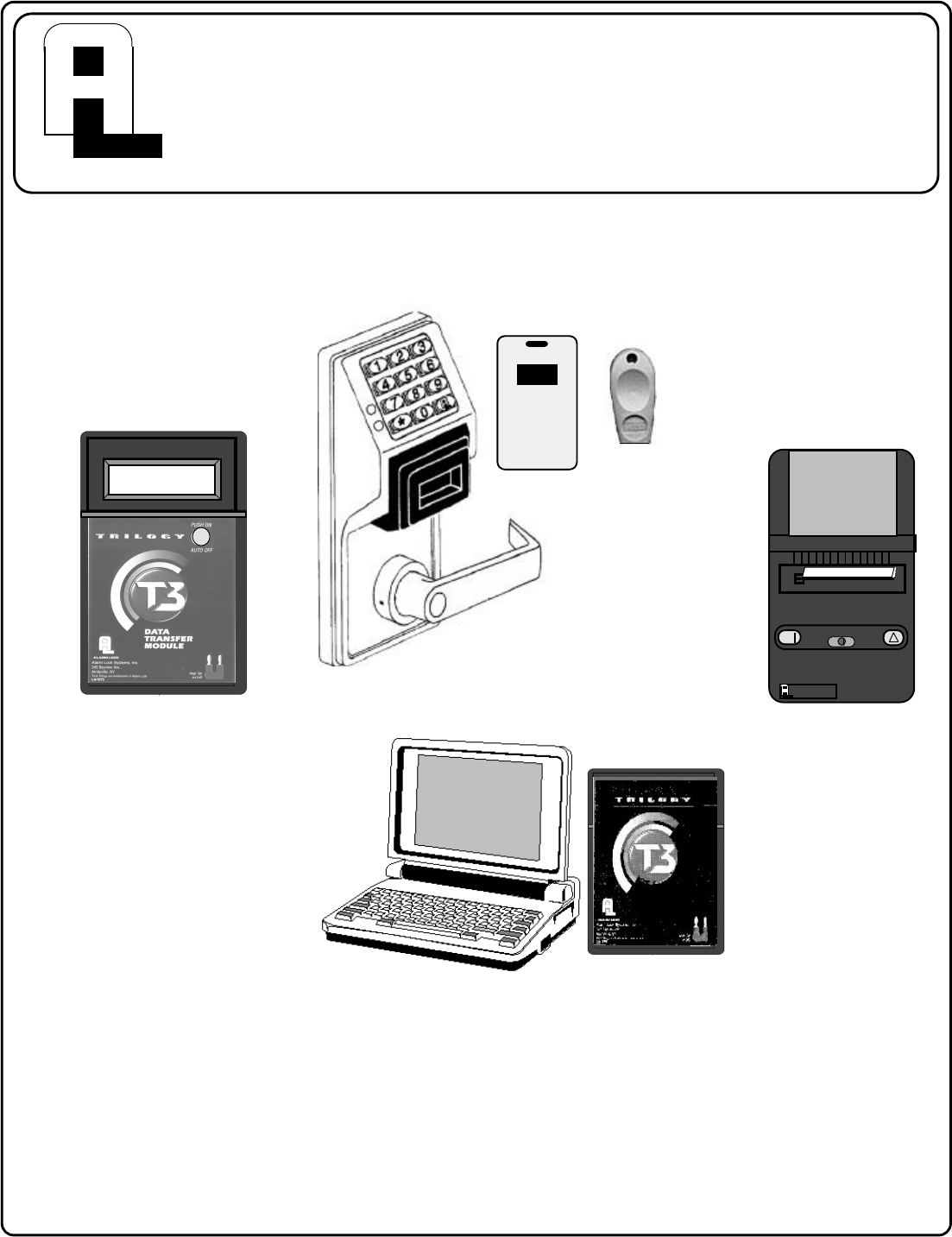
1
Trilogy Series
PDL3000 Programming Instructions
WI1021 10/00© ALARM LOCK 2000
ALARM LOCK
ALARM LOCK
PDL3000 Trilogy Series
Standalone Access Control System
with ProxCard Access
PLUG IN THEN
ENTER YOUR CODE
HIDHID
HID CORPORATION
Prox
Card
Reader
AL-DTM (Version 1)/AL-DTM2
DATA TRANSFER MODULE
PROX CARD READER
AR-IR1 PRINTER
PROX CARD
KEYFOB

2
Features ------------------------------------------------------------------------------------------------------------------------ 4
Audit Trail ------------------------------------------------------------------------------------------------------------------ 4
User Features ------------------------------------------------------------------------------------------------------------ 4
User Access --------------------------------------------------------------------------------------------------------------- 4
Prox Card Features ----------------------------------------------------------------------------------------------------- 4
500 Scheduled Events ------------------------------------------------------------------------------------------------- 5
Keypad and Computer Programming ------------------------------------------------------------------------------- 5
Accessories ------------------------------------------------------------------------------------------------------------------ 5
AL-IR1 Infrared Printer -------------------------------------------------------------------------------------------------- 5
AL-DTM2 Data Transfer Module ------------------------------------------------------------------------------------- 5
Prox Card Reader ------------------------------------------------------------------------------------------------------- 5
Additional Features ------------------------------------------------------------------------------------------------------ 6
Ambush Function -------------------------------------------------------------------------------------------------------- 6
Users Associated with more than one Group --------------------------------------------------------------------- 6
Service Code ------------------------------------------------------------------------------------------------------------- 6
Keypad/Prox Card Lockout -------------------------------------------------------------------------------------------- 6
Non-Volatile Memory ---------------------------------------------------------------------------------------------------- 6
Error Checking ----------------------------------------------------------------------------------------------------------- 6
Real Time Clock --------------------------------------------------------------------------------------------------------- 6
Programmable Relay Functions -------------------------------------------------------------------------------------- 6
Programmable Timeout Functions ----------------------------------------------------------------------------------- 6
Advanced Features ------------------------------------------------------------------------------------------------------ 6
Group 1 Initiated Functions -------------------------------------------------------------------------------------------- 6
Wiring and Power Up----------------------------------------------------------------------------------------------------- 7
Wiring ----------------------------------------------------------------------------------------------------------------------- 7
Self Diagnostic Indications -------------------------------------------------------------------------------------------- 7
Battery Replacement ---------------------------------------------------------------------------------------------------- 7
Power Up - Retain Lock Programming ----------------------------------------------------------------------------- 7
Power Up - Erase all Programming --------------------------------------------------------------------------------- 7
Preliminary Information ------------------------------------------------------------------------------------------------ 8
Lock Operation ----------------------------------------------------------------------------------------------------------- 8
Programming - Notes --------------------------------------------------------------------------------------------------- 8
Programming Information ---------------------------------------------------------------------------------------------- 8
Visible LED and Audible Sounder Indicators ---------------------------------------------------------------------- 8
Getting Started ------------------------------------------------------------------------------------------------------------- 9
Battery Installation ------------------------------------------------------------------------------------------------------- 9
Entering Program Mode ------------------------------------------------------------------------------------------------ 9
Setting the Clock --------------------------------------------------------------------------------------------------------- 9
User Programming ------------------------------------------------------------------------------------------------------- 10
Programming the PDL3000 for Prox Card Access --------------------------------------------------------------- 10
High Security Access (Prox Card + User Code) ------------------------------------------------------------------ 10
Deleting a Prox Card/User Code ------------------------------------------------------------------------------------- 11
Prox Card Batch Enroll-------------------------------------------------------------------------------------------------- 11
Printer Functions ---------------------------------------------------------------------------------------------------------- 11
Printing Time, Date and Day ------------------------------------------------------------------------------------------ 11
Printing User Code List ------------------------------------------------------------------------------------------------- 11
Printing the Audit Trail -------------------------------------------------------------------------------------------------- 11
Methods of Programming -------------------------------------------------------------------------------------------- 12
Lock Operation ------------------------------------------------------------------------------------------------------------- 13
Verifying User Codes --------------------------------------------------------------------------------------------------- 13
Verifying Prox Card Access ------------------------------------------------------------------------------------------- 13
Verifying High Security Access (User Code and Prox Card ) ------------------------------------------------- 13
Quick Reference - Programming Functions --------------------------------------------------------------- 14
Programming Functions----------------------------------------------------------------------------------------------- 15

3
Function Number
1. New Master Code -------------------------------------------------------------------------------------------------------------- 15
2. Add/Delete/Change User Codes ----------------------------------------------------------------------------------------- 15
3.-4. User Enable/Disable ---------------------------------------------------------------------------------------------------------- 16
5. User Enable with Timeout --------------------------------------------------------------------------------------------------- 16
6.-7. User Lockout Mode ----------------------------------------------------------------------------------------------------------- 16
9. Enable User 300 (Service Code) ----------------------------------------------------------------------------------------- 16
10. Erase All Users Except the Master Code ------------------------------------------------------------------------------ 16
12. Clear All Schedules and Timeout Functions -------------------------------------------------------------------------- 17
13. Clear All Timeout Functions ------------------------------------------------------------------------------------------------ 17
14.-23. Group Enable/Disable -------------------------------------------------------------------------------------------------------- 17
25.-34. Group Enable/Disable with Timeout ------------------------------------------------------------------------------------- 18
35. Group Add/Delete Association -------------------------------------------------------------------------------------------- 18
38. Set Date -------------------------------------------------------------------------------------------------------------------------- 19
39. Set Time -------------------------------------------------------------------------------------------------------------------------- 19
40. Set Weekday--------------------------------------------------------------------------------------------------------------------- 19
41. Set Daylight Savings Time -------------------------------------------------------------------------------------------------- 19
43.-44. Clock Adjust---------------------------------------------------------------------------------------------------------------------- 20
45.-46. Passage Mode Enable/Disable - Schedule will Override --------------------------------------------------------- 20
47. Timed Passage Mode -------------------------------------------------------------------------------------------------------- 20
48.-50. Passage Mode Enable/Disable - Schedule will not Override ---------------------------------------------------- 21
51. Passage Mode Configuration ---------------------------------------------------------------------------------------------- 21
52.-54. Pass Time ------------------------------------------------------------------------------------------------------------------------ 21
55.-57. Printer Functions --------------------------------------------------------------------------------------------------------------- 22
58. Upload/Download PC Data -------------------------------------------------------------------------------------------------- 22
59. AL-DTM2 Door Number ----------------------------------------------------------------------------------------------------- 23
60.-61. Lockout ---------------------------------------------------------------------------------------------------------------------------- 23
64.-65. Remote Input -------------------------------------------------------------------------------------------------------------------- 23
66. Ambush Code ------------------------------------------------------------------------------------------------------------------- 23
67.-68. Relay / System Features ---------------------------------------------------------------------------------------------------- 24
69.-70. Enter Key ------------------------------------------------------------------------------------------------------------------------- 25
72.-73. Scheduled Passage Mode Unlock/Lock ------------------------------------------------------------------------------- 25
74.-83. Scheduled Group Enable/Disable ---------------------------------------------------------------------------------------- 25
84.-87. Quick Schedules---------------------------------------------------------------------------------------------------------------- 26
88.-89. Scheduled Passage Mode - Group 1 Activated ---------------------------------------------------------------------- 26
90.-91. Scheduled Relay Activation - Group 1 Activated --------------------------------------------------------------------- 27
92.-93. Scheduled Group 4 Enable - Group 1 Activated --------------------------------------------------------------------- 28
99. Clear Programming ----------------------------------------------------------------------------------------------------------- 28
Using Advanced Features -----------------------------------------------------------------------------------------------29
Programming Record Sheet --------------------------------------------------------------------------------------------30
User Code Record Sheet--------------------------------------------------------------------------------------------------31
Schedule Record Sheet ---------------------------------------------------------------------------------------------------32
Definitions ----------------------------------------------------------------------------------------------------------------------33
Warranty--------------------------------------------------------------------------------------------------------------------------36
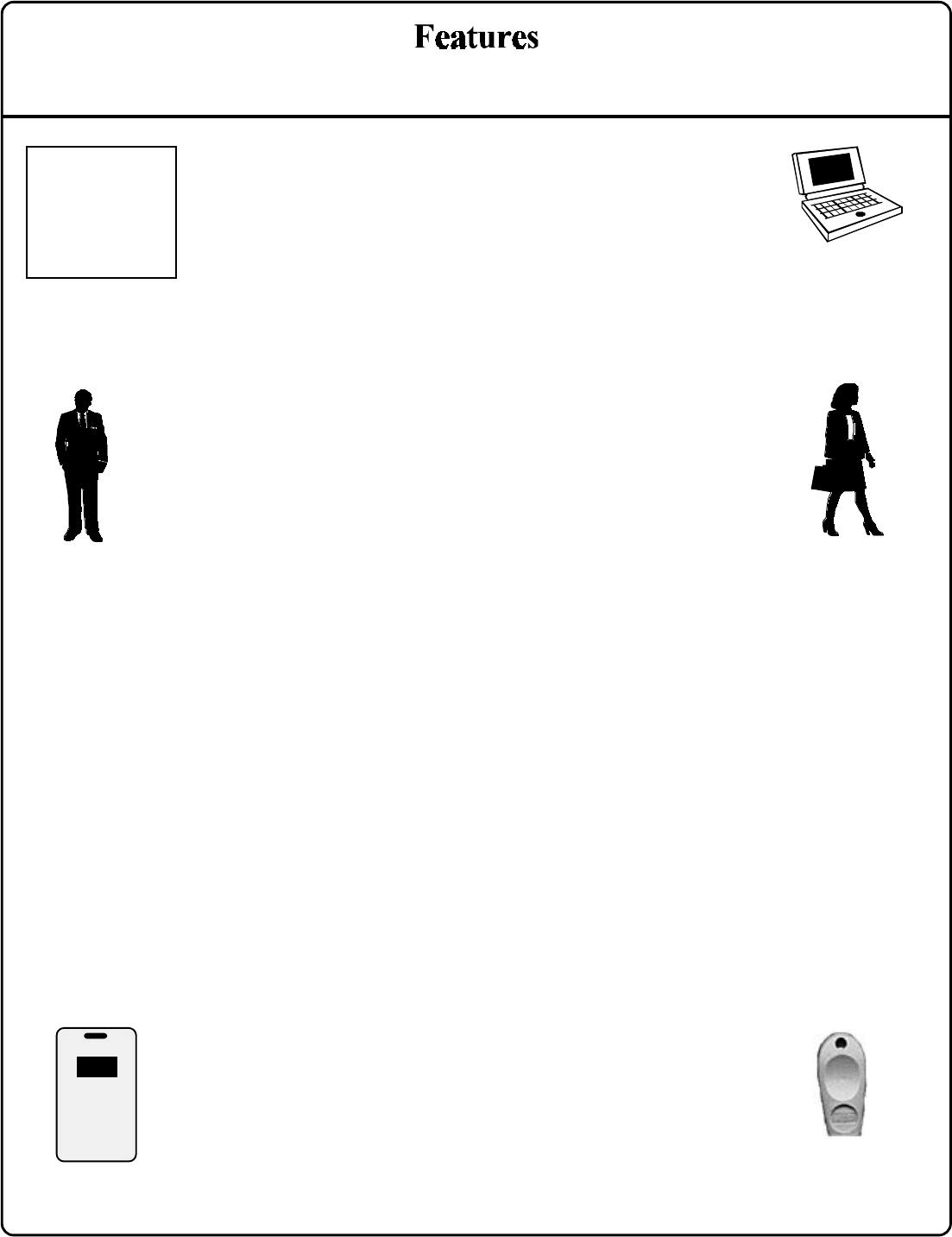
4
User Features
• 2000 User Codes
• Master, Installer, Manager, Supervisor, Print Only and Basic
User Codes
• 3, 4, 5 or 6 Digit User Codes
• Service Code (One-Time-Only Code)
• User Lockout Mode - Total user lockout except User 1 code
• 4 User Groups
User Access
• User Codes
• Prox Card
• Keyfob
• User Code + Prox Card (Highest Security)
Notes:
Prox Cards and Keyfobs both function the same. Keyfobs can
be replaced for all references to Prox Card.
Keypad Access and Prox Card/Keyfob Access function the
same. All references to Keypad Entry also apply to Prox Cards
Audit Trail - 40,000 Events *
• Time/Date Stamped Log of all Entries
• Logs Program Mode changes
• View Audit Trail:
Print using the AL-IR1 hand-held printer
Upload using Alarm Lock's DL-WINDOWS Software
Use Alarm Locks AL-DTM2 to upload multiple lock logs
------- AUDIT LOG -------
08/25/00 13:06:35 Tue
13:01:59 001 PROGRAM 56
13:01:29 001 PROGRAM 57
13:00:53 001 ENTRY
13:00:26 013 ENTRY
13:00:03 012 ENTRY
12:56:27 001 PROGRAM 2
12:56:27 001 PROGRAM 40
12:56:04 001 PROGRAM 39
12:55:00 NEW CLCK TIME
12:01:39 OLD CLCK TIME
12:00:45 RAM TEST:PASS
12:00:45 POWER UP
-------------------------
End of Audit Log
The Alarm Lock PDL3000 Series Trilogy Standalone Access Control System is a State-Of-The-Art
Microprocessor Based Programmable Keypad-Entry and PROX Security Lock.
PROX Features
• Batch Enroll - Quickly and easily enroll multiple PROX Cards/
Keyfobs without the use of a PC.
• HID PROX Compatible - compatible with most HID Prox Cards/
Keyfobs.
Compatible with 26 bit, 33 bit and 37 bit Prox Cards and Keyfobs.
HIDHID
HID CORPORATION
* AL-DTM2 transfers 5,000 events.
AL-DTM (Version 1) transfers first 1,200 events.
* AL-DTM2 transfers 2,000 User Codes.
AL-DTM (Version 1) transfer first 100 User Codes.
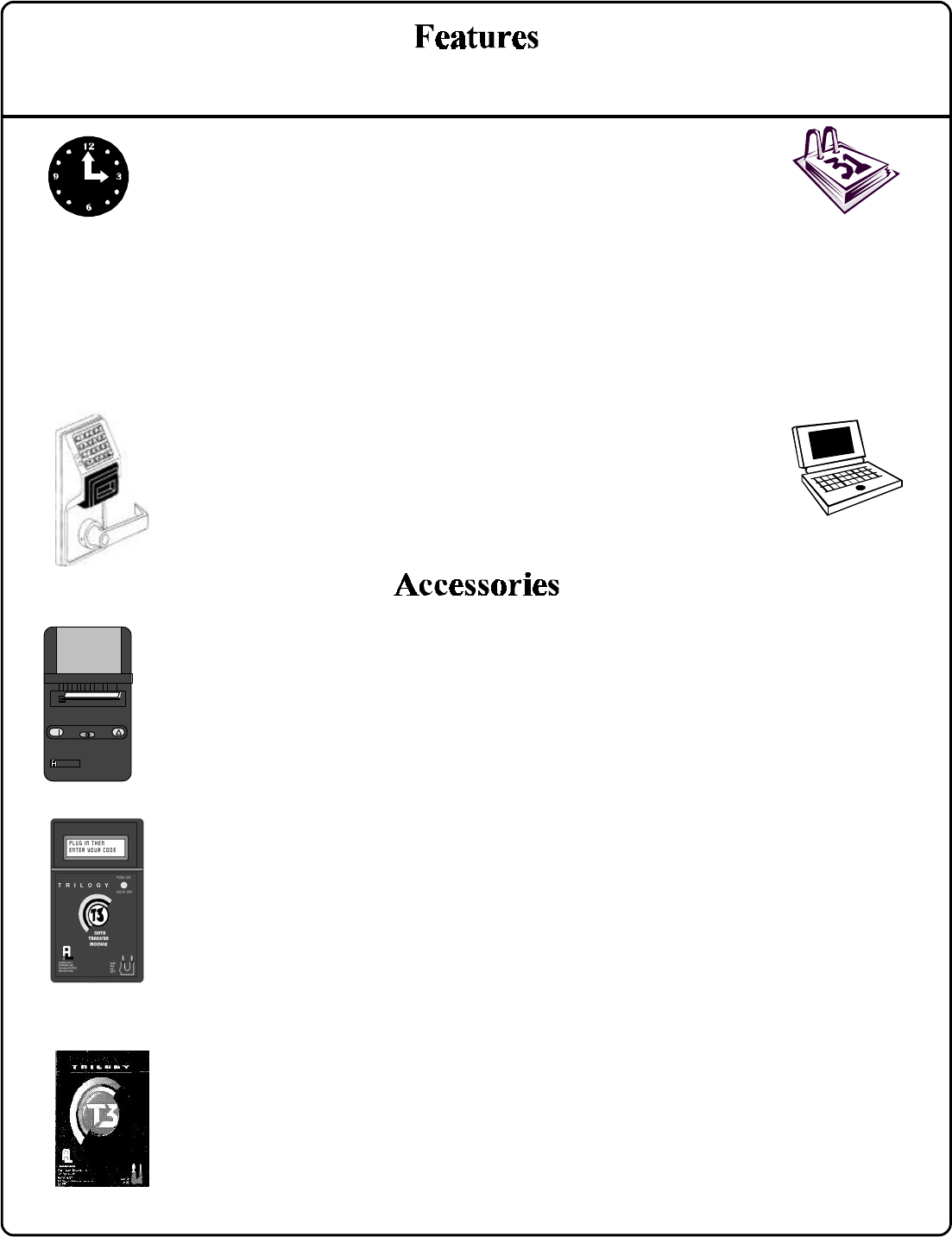
5
The Alarm Lock PDL3000 Series Trilogy Standalone Access Control System is a State-Of-The-Art
Microprocessor Based Programmable Keypad-Entry and PROX Card Security Lock.
Keypad and Computer Programming
• All programming may be done manually from the keypad, or
from a PC using Alarm Lock's DL-Windows Software.
• Batch Enroll - Allows programming multiple Prox Cards without
the use of a PC.
AL-DTM2 Data Transfer Module
• Optional Hand-held Data Transfer Module. The AL-DTM2 may
be used to easily transfer program data between up to 96 locks
and a PC running DL-WINDOWS software. Easily transfer
Audit Trail from multiple locks and then view or print each Audit
Trail from a computer.
• AL-DTM (version 1) may be used; however limited to 48 Locks
and the first 100 users.
AL-IR1 Infrared Printer
• Optional hand-held infrared printer may be used to print the
Audit Trail and User Code List.
ALARM LOCK
Prox
Card
Reader
Prox Card Reader
• Optional Prox Card Reader allows quick and easy
programming of Prox Cards and Keyfobs without the need to
enter codes when using DL-WINDOWS software to program
PDL3000 locks.
500 Scheduled Events *
• Programmed to Unlock/Lock
• Enable/Disable Users
• Enable/Disable Groups
• Group 1 Activated Events
• 4 "Quick Schedules" - allows programming of the 4 most
common time schedules in one step
* AL-DTM2 transfers all 500 scheduled events.
AL-DTM (Version 1) transfer first 150 scheduled events.
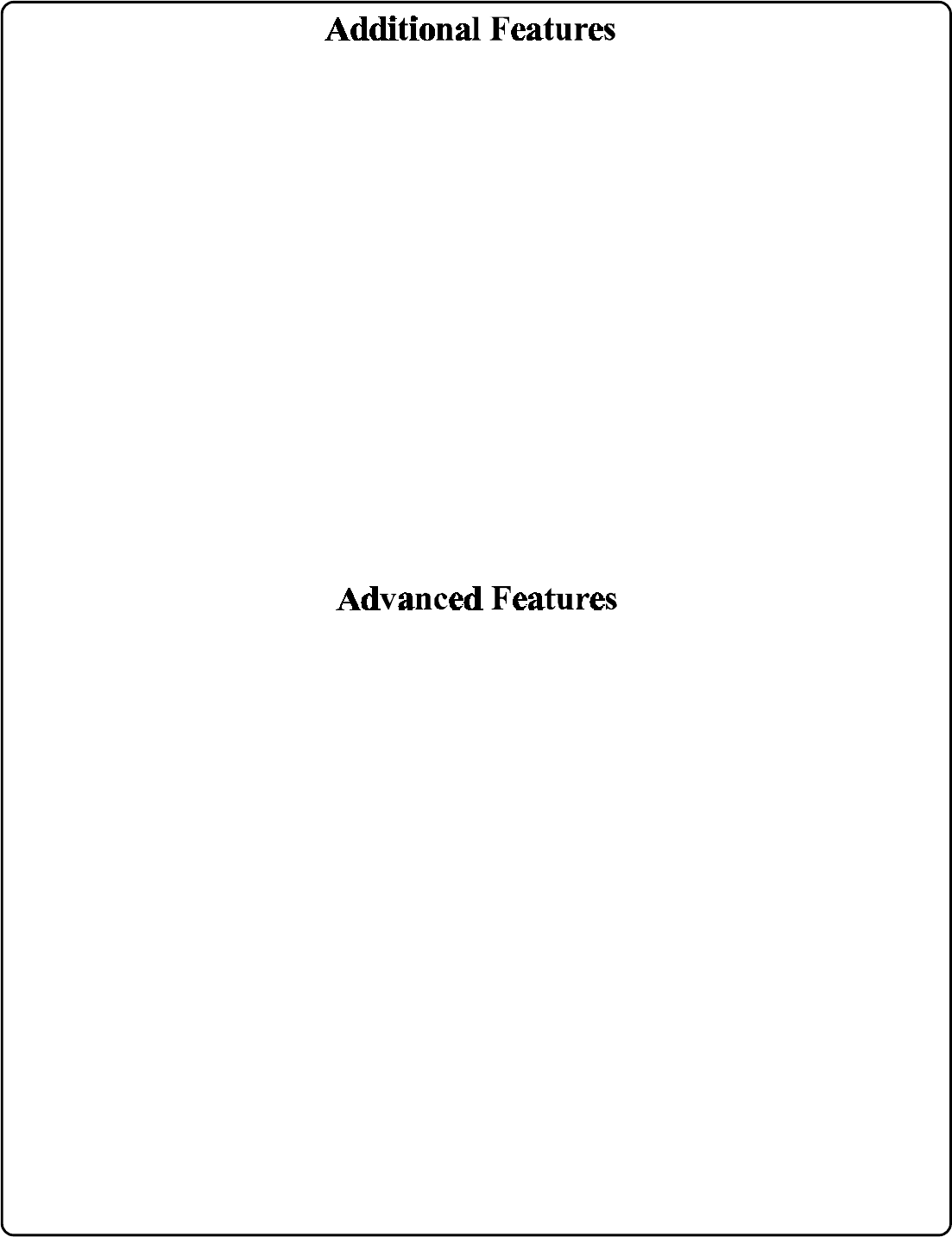
6
Ambush Function
1. Connect relay to a device able to properly monitor dry
contacts for an ambush condition.
2. Program the Relay for Ambush Function Activated
using Program Function 67(10).
3. Set the Ambush Code using Program Function 66.
4. When the ambush code is entered followed by a valid
user code, the relay will close for 2 seconds.
Ambush Code
The ambush code defaults to 99.
User Code
An error will sound if you try to program a new user
code starting with the ambush code.
Users Associated with more than one
Group If a user is associated with more than one group,
all associated groups would have to be disabled before
the user is disabled.
Service Code
User number 300 is the service code. Once the service
code is used, it is disabled. Function 9 or User Number
297 is used to re-enable the service code.
Keypad Lockout
Programmable number of attempts before keypad lockout.
Programmable lockout time.
Non-Volatile Memory
All programming is stored in non-volatile memory.
Error Checking
Extensive keypad program error checking reduces the
likelihood of a programming error.
Real Time Clock
Real time clock allows logging of events to within one
second accuracy. Unique feature (Functions 43/44) allows
speeding up or slowing down the clock providing long term
accuracy of the clock functions to within 3 minutes per year.
Programmable Relay Functions
Relay may be programmed to energize when one or more
selected events occur.
Programmable Timeout Functions
Timeout functions allow enabling/disabling users and
enabling passage mode for a time period without requiring
the user to return to the lock.
Note: The alarm panel will have to be armed at night by
the user or by an automatic schedule function of
the alarm panel.
Example: Open window at 7:00AM using Program
Function 90, Close Window at 8:30AM using Function
91. The relay will close, one time only, when a member
of Group 1 enters their code between 7:00AM and
8:30AM.
Group 1 Member Enables Group 4 Users
1. Use Function 92 to set the time to open the window
allowing any Group 1 member to enable Group 4.
2. Use Function 93 to set the time to close the window.
Note: Group 4 will have to be disabled each night using
Function 17 or schedule Function 82. Example: Open
window at 7:00AM using Function 92, close window at
8:30AM using Function 93.Group 4 will be enabled when
a member of group 1 enters their code between 7:00AM
and 8:30AM (Group 4 users will have to wait outside until
a manager arrives to enable their codes. If a manager
does not arrive between 7:00AM and 8:30AM, Group 4 is
not enabled.
Group 1 Member puts unit in Passage Mode
Feature (88 & 89)
1. Use Function 88 to set an Open Time Window. The
lock will unlock (Passage Mode) when any Group 1
Member enters a code.
2. Use Function 89 to set the time to close the window.
Note: Passage Mode will have to be disabled each night
using Function 46 or schedule Function 73.
Example: Open window at 7:00AM using Function 88,
Close Window at 8:30AM using Function 89.
Lock will unlock when a member of Group 1 enters their
code between 7:00AM and 8:30AM. If no Group
1member arrives between 7:00AM and 8:30AM, the lock
will stay locked all day.
Group 1 Member Disarms Burglary Control
Panel (90 & 91)
1. Connect relay to a burglar control panel with switch
input for disarming.
2. Use Function 90 to set the time to open the window
allowing any Group 1 member to close the relay
for 2 seconds. Note: Only 1 relay closure will occur even
if another member of Group 1 enters their code.
3. Use Function 91 to set the time to close the window.

7
Wiring
Red / Black (Operation without Batteries) - Optional
External 7.5 VDC Power Source must be used for operation
without batteries.
White / White (Remote Input) - Wire a Normally Open
Contact to wires (white and white). Momentarily close to
allow person to pass through door. NOTE: Remote Input is
enabled from the factory.
Relay: COM-Blue / NO-Yellow / NC-Green - See Function
67 for programming options for the Relay.
Self Diagnostic Indications
Various system tests are performed at power up and during
operation of the lock.
Steady 4 Second Sounder with a Yellow LED indication
every time a user code is entered - Indicates a Low
Battery Condition.
Continuous Series of Beeps - Indicates the lock detected
a system fault which would not allow any part of the system
to operate. Ensure batteries are good.
Sequence of 7 Beeps Repeated 4 Times with a Yellow
LED Indication, every time a user code is entered -
indicates a non-fatal memory or clock error has been
detected. Under this condition, unexpected operation is
possible. Do not mistake the low battery indication as a
memory or clock error.
Wiring to Disarm a Burglary Control Panel
See illustration on connecting the PDL3000 to an Alarm Panel.
Scheduled Relay Activation - Group 1 Activated (Function
90/91) on on page 27.
The Three Methods of Powering Up are:
• Battery Replacement
• Power-Up Retain Lock Programming
• Power-Up Erase All Programming
Battery Replacement
When a valid code is entered and the batteries are weak the
lock LED will display a yellow color, and the sounder will
sound for 4 seconds. The PDL3000 uses 5 AA-size 1.5 volt
alkaline batteries. The lock will function with weak batteries;
however be sure to replace the batteries as soon as
possible.
Remove the screw at the bottom of the housing and remove
the cover. Pull out the battery pack and replace all 5
batteries quickly - within 1 minute. Note: Do not press any
buttons while replacing the batteries (unless lock
programming is to be erased). Pressing any key will remove
the voltage that is required to keep the system clock.
Power-Up - Retain Lock Programming
(Clock Settings lost)
1. Disconnect battery pack connector.
2. Press any key to insure the locks capacitor is fully
discharged.
3. Re-install battery pack (lock will give 3 short beeps).
4. Do not press any keys for 10 seconds.
5. After the 15 second period the LED will flash red 6 times
and 6 beeps will sound.
The lock is now ready for use. Program is loaded from non-
volatile memory. Set the clock using functions 38, 39 and 40.
Power-Up - Erase All Programming
(Factory Default will be loaded)
1. Remove the battery pack.
2. Press any key to insure locks capacitor is fully
discharged.
3. Re-install the battery pack (lock will give 3 short beeps).
4. Press any key within 5 sec after hearing the 3 beeps.
5. A series of 5 RED LED and 5 beeps will be heard
followed by 10 seconds of silence, 3 GREEN LED and 3
fast beeps.
All programming has been erased and the lock is now ready
for use.
Note: All lock programming can also be erased by entering
Function 99.
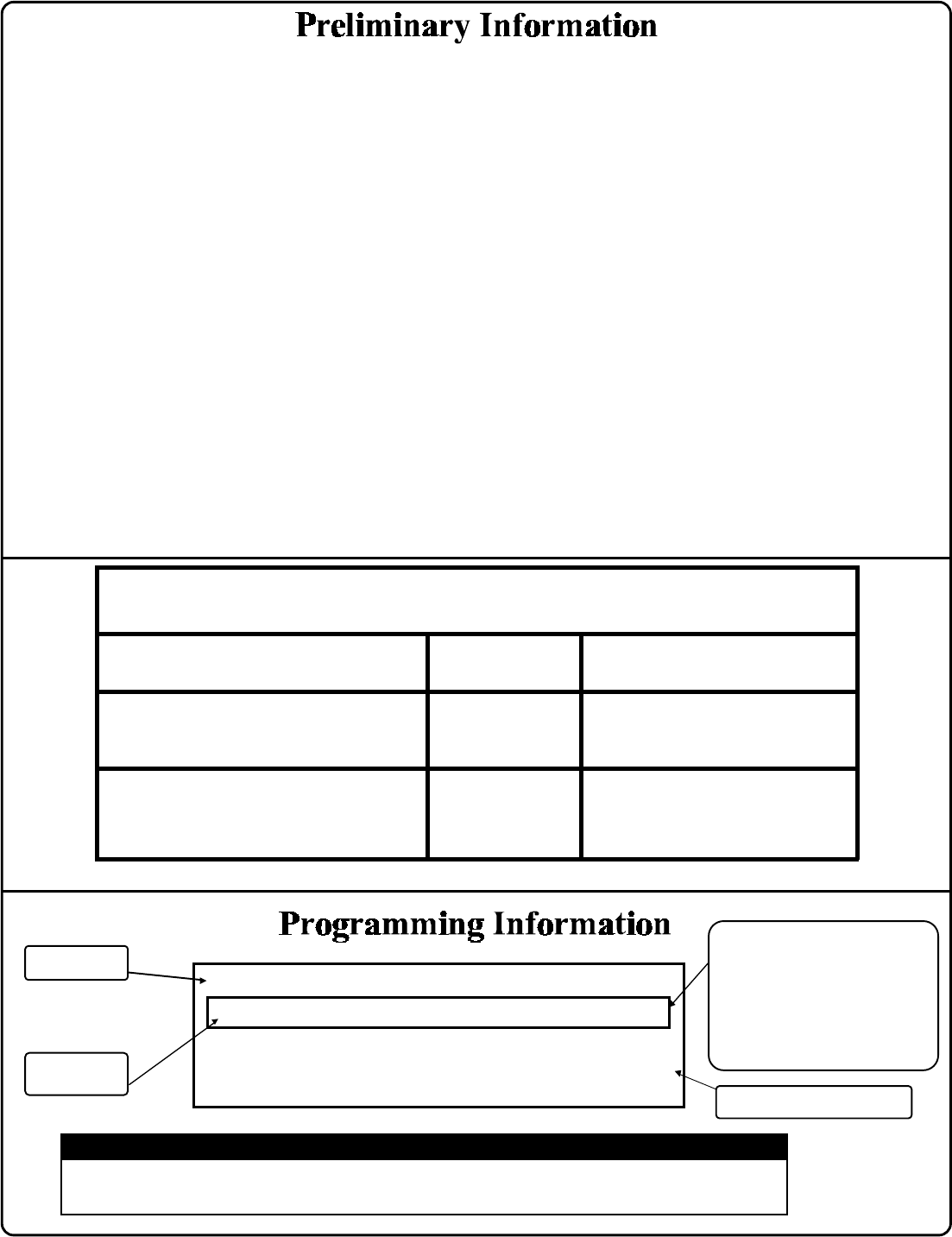
8
Lock Operation
Important: Before attempting to program any codes or
functions, Note the following:
• While the lever or knob may be rotated at any time, the latch
will not be engaged to unlock the door unless a valid code
has been entered.
• When a valid code is entered, the lock will unlock
immediately and remain unlocked for about 3 seconds (or
longer, if reprogrammed by functions 53 and 54).
Programming - Notes
It is recommended that all programming be prepared in
advance using the PDL3000 Programming Sheets for
reference while programming. User Code and Schedule
Recording sheets are provided on pages 30, 31 and 32.
Secure Programming Sheets when finished.
PROGRAM LEVELS
You must have the programming authority level equal to the
authority level required to access a programming function.
Programming authority levels can have a value of 1, 2, 3, 4 or
M. A programming authority level of M (Master) is associated
with the Master Code and cannot be associated with any other
user.
CODE TYPES
Program level ability is fixed according to table on page 15.
The codes are defaulted to the tabulated group associations
when adding codes using Program Function 2.
Master Code - User 1: Always enabled and can program all
functions, can't be group associated.
Installer Codes - Users 2 & 3: Allow all functions except
master code change.
Manager Codes - Users 4 - 6: Can program all functions
except functions relating to lock configuration, no default group
association.
Supervisors - User 7 - 9: Can only program functions relating
to day to day operation, no default group association.
Print Only Codes - Users 10 & 11: Allow access to print audit
trail only.
Basic User Codes: No program ability, default group
association.
Program Level Required - The
program level required to access
the Function. Possible
Programming Levels of 1,2,3,4 and
M, where M = Master Code.
Program Authority Level of User
must be equal to the Function that
is to be accessed.
3. Disable User ; 3 ; [ _ _ _ ] :
4. Enable User ; 4 ; [ _ _ _ ] :
• User Number must be between 2 and 2000. 2
Enabling/Disabling Users (By User Number)
Programming key sequence.
Function Name
Programming
Information
If a wrong key is pressed during code entry, hold any key continuously until the error sound is heard (7 short beeps),
this will clear the entry. Re-enter the key sequence again.
General Program Mode Information
Visible LED and Audible Sounder Indicators
Normal Battery
Activity LED SOUNDER
Keypress 1 RED Flash 1 Beep
Enter Valid Enabled Code 3 GRN
Flashes 3 Beeps
Enter Invalid No/Wrong Code 6 RED Flashes 6 Beeps
Successful Program Entry 2 GRN
Flashes 2 Beeps
Unsuccessful Program Entry 7 RED Flashes 7 Beeps
Low Battery is indicated by a Yellow Flash during Key Press and a Long Beep.
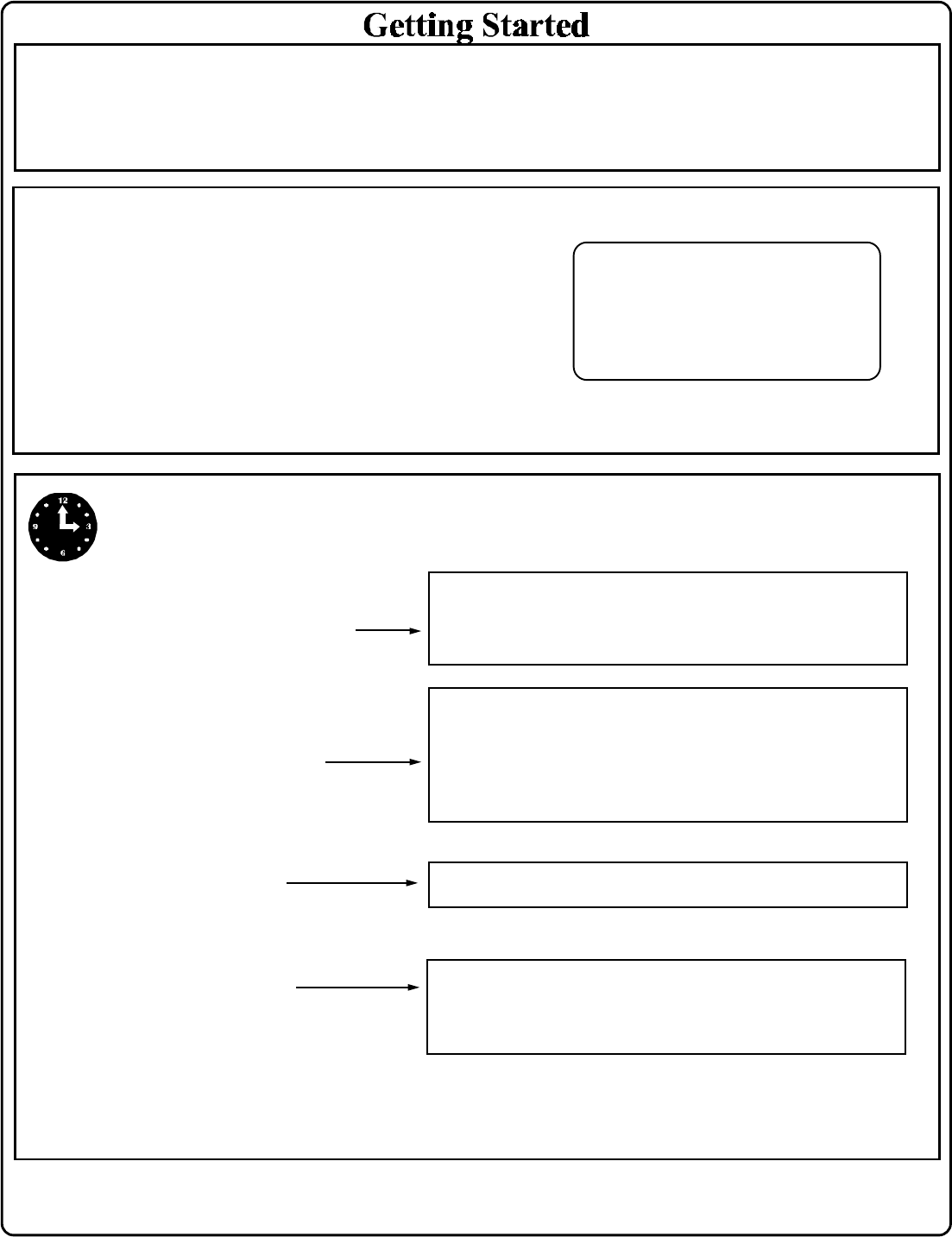
9
Battery Installation
Remove the back cover and install battery pack. The lock will beep 3 times. To load the default program press any
key within 5 seconds, the lock will beep slowly while the default values are loaded and beep rapidly upon completion.
Entering Program Mode
1. Enter Master Code 1 2 3 4 5 6
Default Master Code
2. Press and hold ; until 8 beeps are sounded.
Program a new Master Code.
; 1 ; [ _ _ _ _ _ _ ] ; [ _ _ _ _ _ _ ] :
New Master Code Confirm New Master Code
Setting the Clock - While still in Program Mode enter the following commands to set the clock.
Program the Date.
; 3 8 ; [ _ _ _ _ _ _ ] :
Date
Program the Time.
; 3 9 ; [ _ _ _ _ ] :
Time
Program the Weekday.
; 4 0 ; [ _ ] :
Day
Program Daylight Saving Time.
; 4 1 ; [ _ _ ] :
For Example: To set time to 8:25 P.M.;
Enter: ; 3 9 ; 2 0 2 5 :
For Example: To set time to 8:25 A.M.;
Enter: ; 3 9 ; 0 8 2 5:
For Example: August 25, 2000;
Enter:
; 3 8 ; 0 8 2 5 0 0 :
For day enter: 1 for Sunday, 2 for Monday, 3 for Tuesday, 4 for Wednesday,
5 for Thursday, 6 for Friday and 7 for Saturday.
Program Mode
The keypad sounder will beep every 6 seconds
and the keypad LED will flash green every 6
seconds while in program mode when no keys
are pressed. NOTE: There is a 3 minute
Timeout if no keys are pressed while in
Program Mode.
For Example: To program the Default DST Mode;
Enter: ; 4 1 ; 1 2 :
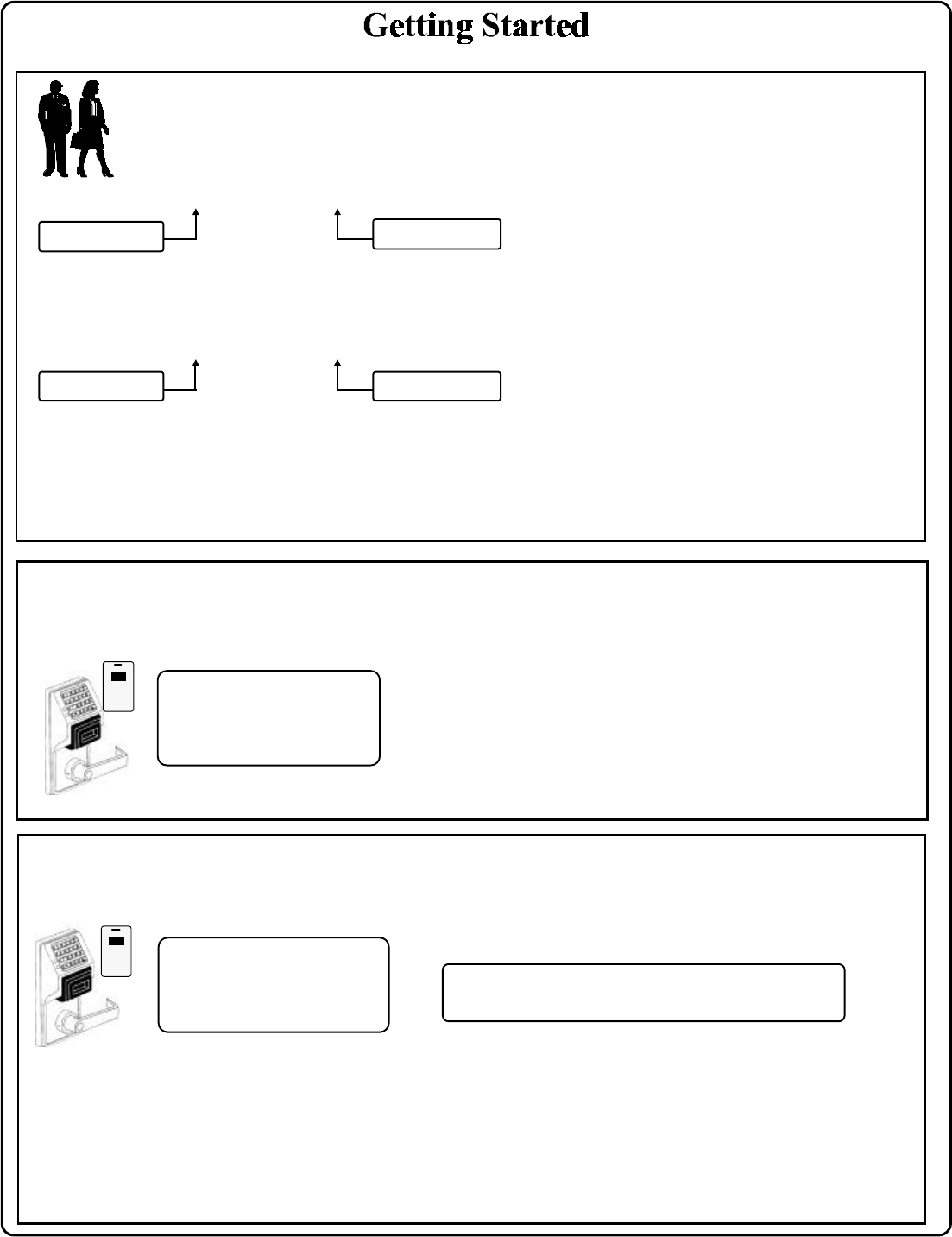
10
User Programming
Add a Basic User Code
Program a User Code of 987. Use Function 2, and add the new user as User 12. Refer to Function 2 (page 15).
; 2 ; 1 2 ; 9 8 7 :
Add another Basic User Code
Program a User Code of 246. Use Function 2, and add the new user as User 13. Refer to Function 2 (page 15).
; 2 ; 1 3 ; 2 4 6 :
Programming the PDL3000 for ProxCard Access
Program the PDL3000 for ProxCard Access as User 14.
; 2 ; 1 4 : [Beep Beep Beep ... Beep]
High Security Access (ProxCard + User Code Access)
Program the PDL3000 for High Security Access for User 15. A ProxCard and User Code are required for access.
; 2 ; 1 5 : [Beep Beep Beep ... Beep]
Program a User Code of 7452. Use Function 2, and add the new user as User 15. Refer to Function 2 (page 15).
; 2 ; 1 5 ; 7 4 5 2 :
In order for User 15 to open the Lock, a User Code must be entered and a ProxCard must be presented to the PDL3000 Lock. User may enter
code or present card in either order to open the lock. The sounder will beep for up to 10 seconds, waiting for the User to enter code/present card.
User Code Conflicts
Care should be taken not to program a new user code which matches the first digits of any other user code (only the code with the
least number of digits would be recognized). Example: If user codes 123 and 123456 are both entered in the system only code 123
would be recognized, unless the ENTER Key has been enabled (Function 69).To program user codes that match the first digits of
other codes, see program Function 69. An error will sound if you try to program a new user code which matches the first digits of the
Master User Code.
User Number (12) Code for User 12
User Number (13) Code for User 13
The sounder will beep rapidly for 10
seconds. Present a CARD to the lock
while the sounder is still beeping. The
CARD is now programmed for access
by user 14.
The sounder will beep rapidly for 10
seconds. Present a CARD to the lock
while the sounder is still beeping. The
CARD is now programmed for access by
user 15.
Note: For High Security Access, the user can present the card first or
enter the CODE first. In either case the sounder will beep slowly for up to
10 seconds waiting for the user to complete the sequence.
Present CARD for User 14 within the 10-second period, the beeping
will stop after the Prox Card has been programmed.
Present CARD for User 15 within the 10-second period, the
beeping will stop after the Prox Card has been programmed.
HIHI
HIHI
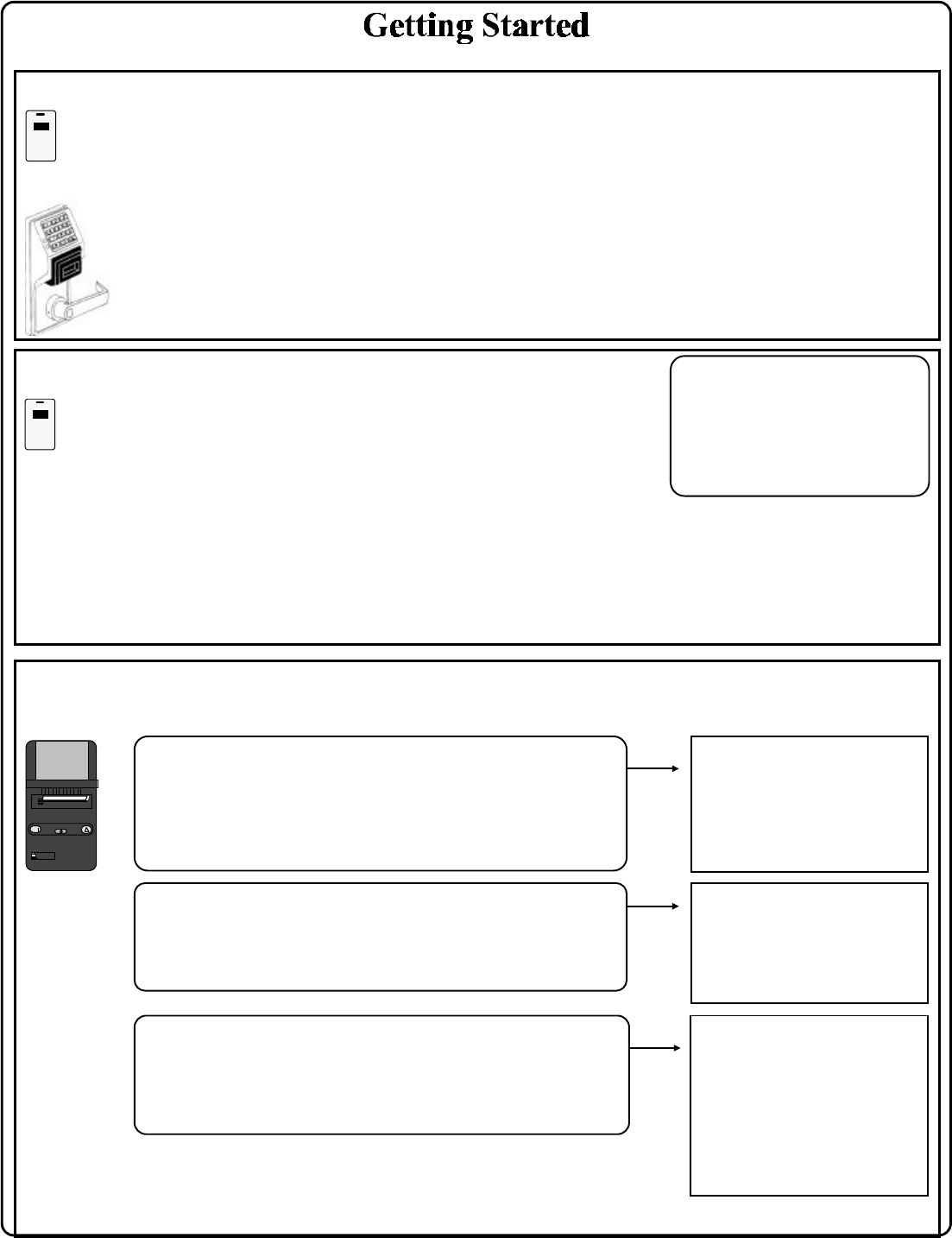
11
ALARM LOCK SYSTEMS, INC
VERSION 9.00 org REC
08/25/00 13:11:28 Fri
Clock adjust setting +0
Cycle count hex 00000E
F39 day ct hex 00
Door # 01
Printing the Lock’s Time, Date and Day. Refer to
Printer Functions (page 22) for proper Printer-Lock
positioning.
From Program Mode enter the following command:
; 5 7 :
User Programming (Continued)
Deleting a ProxCard/User Code
Delete ProxCard Access for the ProxCard programmed for User 12.
; 2 ; 1 2 : [Beep Beep Beep Beep Beep Beep Beep Beep Beep Beep ... Beep]
DO NOT Present a CARD during the 10-second period
The sounder will beep rapidly for 10 seconds.
DO NOT Present a CARD to the lock while the sounder is still beeping.
Wait for the Sounder to stop beeping. The ProxCard and code programmed for user 12 has now been deleted.
Note: Deleting a ProxCard associated with User 12 with also delete the User Code programmed for User 12.
ProxCard Batch Enroll
Program multiple Prox Cards successively using the PDL3000 Batch Enroll Feature.
Program 50 Prox Cards for Users 100-150.
; 2 ; 1 0 0 : [Beep Beep Beep ... Beep]
User 100 (Present CARD for User 100 within 10-second period, the beeping will stop after the ProxCard has been programmed.)
User 101 (Present CARD for User 101 within 10-second period, three beeps will sound at the keypad.) [Beep Beep Beep]
User 102 (Present CARD for User 102 within 10-second period, three beeps will sound at the keypad.) [Beep Beep Beep]
•
•
•
User 150 (Present CARD for User 150 within 10-second period, three beeps will sound at the keypad.) [Beep Beep Beep]
Printer Functions (AR-IR1 PRINTER required)
08/25/00 13:06:35 Fri
USER|USER |GROUP|PROG
NUM |CODE | |LEVL
1 123456 .... 1234
12 987 .... ....
13 246 .... ....
153 7894 .... ....
1843 2457 .... ....
Printing the Lock’s User Code List. Refer to Printer
Functions (page 22) for proper Printer-Lock positioning.
From Program Mode enter the following command:
; 5 6 :
Printing the Lock’s Audit Trail. Refer to Printer
Functions (page 22) for proper Printer-Lock positioning.
From Program Mode enter the following command:
; 5 5 :
ALARM LOCK
------- AUDIT LOG -------
08/25/00 13:06:35 Fri
13:01:59 0001 PROGRAM 56
13:01:29 0001 PROGRAM 57
13:00:53 0001 ENTRY
13:00:26 0013 ENTRY
13:00:03 0012 ENTRY
12:56:27 0001 PROGRAM 2
12:56:27 0001 PROGRAM 40
12:56:04 0001 PROGRAM 39
12:55:00 NEW CLCK TIME
12:01:39 OLD CLCK TIME
-------------------------
End of Audit Log
HIHI
HIHI
Note: Batch Enroll will not program
Users 297 through 300, these are Special
Function User Codes, See Page 15 for
more information. After a Prox Card/
Keyfob for User 296 has been Batch
Enrolled the next card presented will batch
Enroll as User 301.
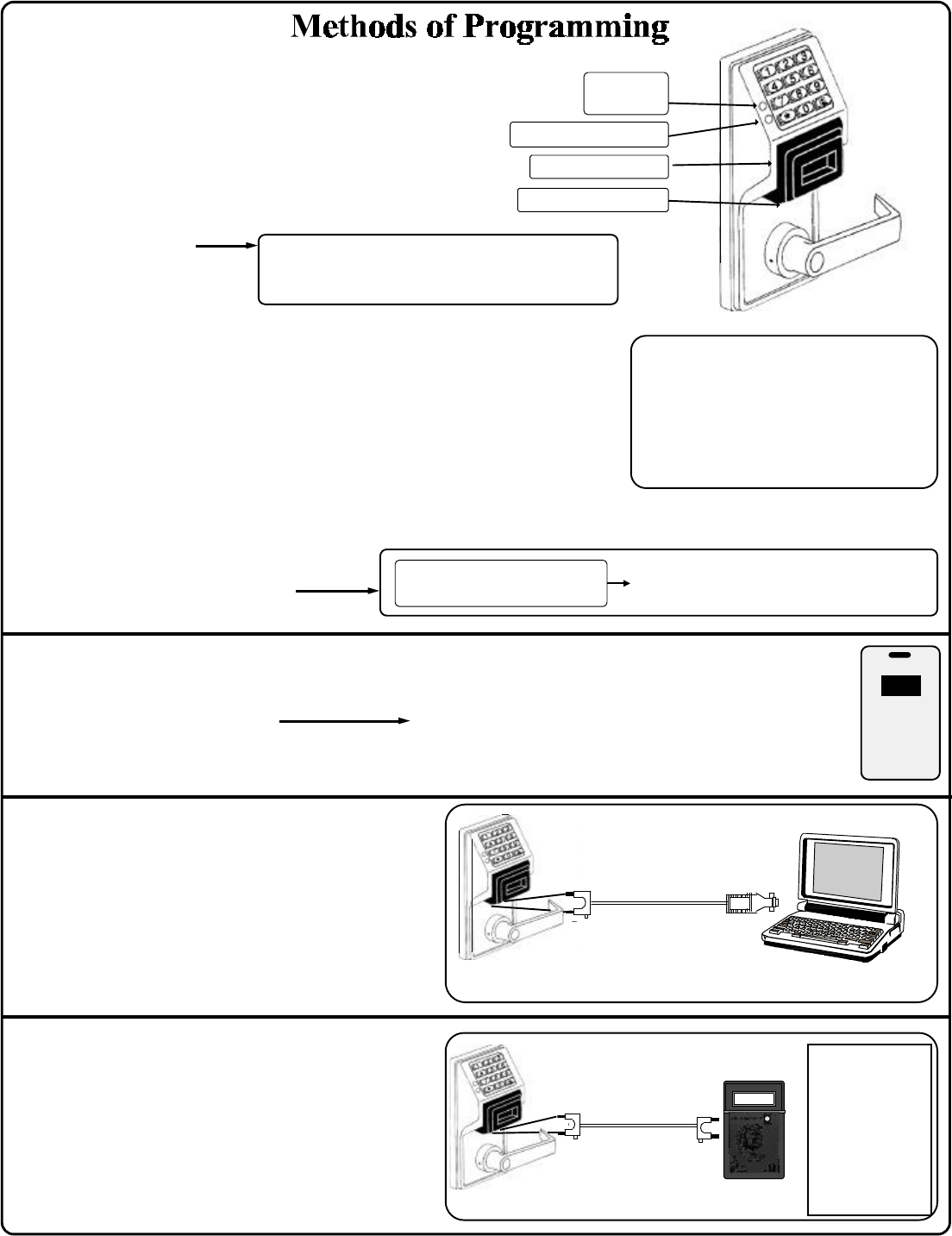
12
Keypad Programming
Entering Program Mode
1. Enter Master Code 1 2 3 4 5 6
Default Master Code
2. Press and hold ;
Program the Master Code
New Master Code (User Number 1)
; 1 ; [ _ _ _ _ _ _ ] ; [ _ _ _ _ _ _ ] :
New Master Code Confirm Master Code
Exiting Program Mode
There are 2 ways to exit Program Mode:
1. Hold down any key for 3 seconds
2. Press no keys for 3 minutes
(Program Mode Timeout).
ProxCard Enroll and Batch Enroll
; 2 ; [ _ _ _ _ ] :
(User Number)
Communication
The PDL3000 lock can also be programmed using a
computer with Alarm Lock's DL-WINDOWS
Software and AL-PCI cable.
“BeepBeep” “BeepBeep” “BeepBeep” “BeepBeep”
Sounder will sound 2 short beeps 4 times to indicate
the program mode is active.
Program Mode
When no keys are pressed, the keypad sounder
will beep every 6 seconds and the keypad LED
will flash green every 6 seconds. NOTE: There
is a 3 minute Program Mode Timeout if no keys
are pressed while in Program Mode. A steady
tone will sound indicating there is 15 seconds left
to press a key or Program Mode will timeout.
Tri-Color
Status LED
Infrared LED (Printer)
PC Interface/AL-DTM2
2 series of 4 Quick Beeps once
the Exit Sequence has initiated. “BeepBeepBeepBeep” “BeepBeepBeepBeep”
The PDL3000 lock can also be programmed using Alarm
Lock's AL-DTM2 Data Transfer Module and a computer
running Alarm Lock's DL-WINDOWS Software.
AL-DTM2
Keypad will Beep for 10 seconds, present ProxCard to
PDL3000. When ProxCard has been programmed, beeping
will stop. Present additional card if desired (Batch Enroll)
HIDHID
HID CORPORATION
DL3500 Lock (mounted on door) IBM COMPATIBLE
LAPTOP COMPUTER
TO SERIAL PORT (DB-9)
E.G. <COM 1>
AL-PCI
-
+
NOTE: Observe Tab Direction
when inserting cable into DL3500 Lock.
PDL3000 Lock (mounted on door)
PDL3000
Note:
AL-DTM2 has been
configured using a
computer running
DL-WINDOWS
software. Refer to
DL-WINDOWS
Software
documentation
OI237.
DL3500 Lock (mounted on door)
-
+
NOTE: Observe Tab Direction
when inserting cable into DL3500 Lock.
-
+
(Tab to the left)
PLUG IN THEN
ENTER YOUR CODE
AL-DTM
PDL3000 Lock (mounted on door)
PDL3000
AL-DTM2
Prox Card/Keyfob
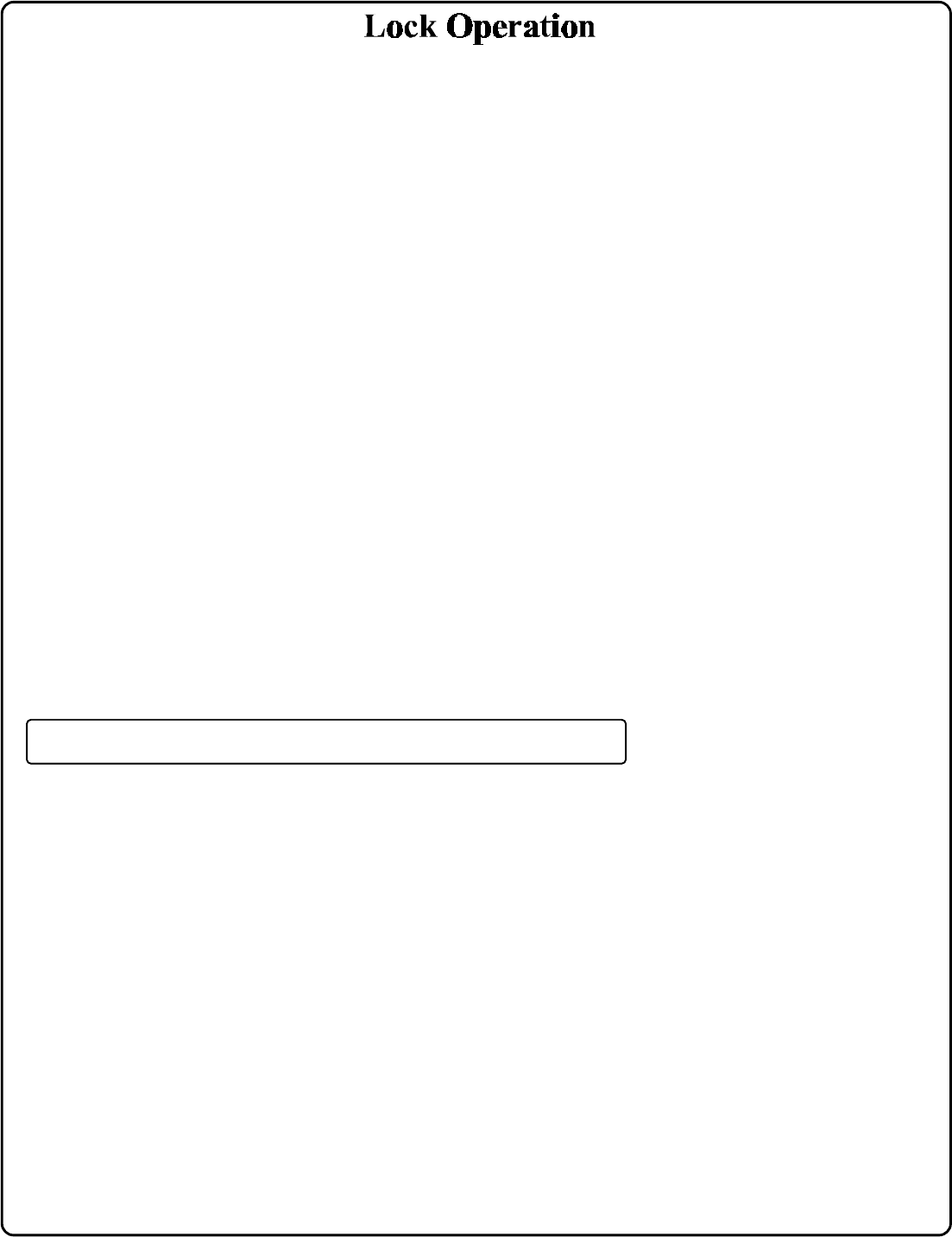
13
Verifying Basic Keypad User Codes
Test User Code Entered in Getting Started for User 12.
Enter 9 8 7
VALID CODE - The Green LED will flash momentarily and the sounder will beep a few times after a valid code is entered.
INVALID CODE - The RED LED will flash several times and the sounder will beep several times after an invalid code is entered.
Use Function 2 to re-program the code.
Verifying Prox Card and Keyfob Access
Test Prox Card programmed for User 14 in Getting Started.
Present the Programmed Card to the PDL3000 lock
VALID CARD - The Green LED will flash momentarily and the sounder will beep a few times after a valid card or keyfob has
been presented to the PDL3000 Lock.
INVALID CARD - The RED LED will flash several times and the sounder will beep several times after an invalid card or keyfob
has been presented to the PDL3000 Lock. Use Function 2 to re-program the code.
Verifying High Security Access (ProxCard + User Code)
Test Prox Card programmed for High Security Access in Getting Started for for User 15. A ProxCard and User Code are
required for access.
1. Enter 7 4 5 2 , The sounder will beep slowly for up to 10 seconds.
2. Present the Card programmed in Getting Started to the PDL3000 Lock.
User may enter code or present card in either order to open the lock. The sounder will beep for up to 10 seconds,
waiting for the User to enter code/present card.
Note: Do not present the Prox Card and enter the User Code simultaneously.
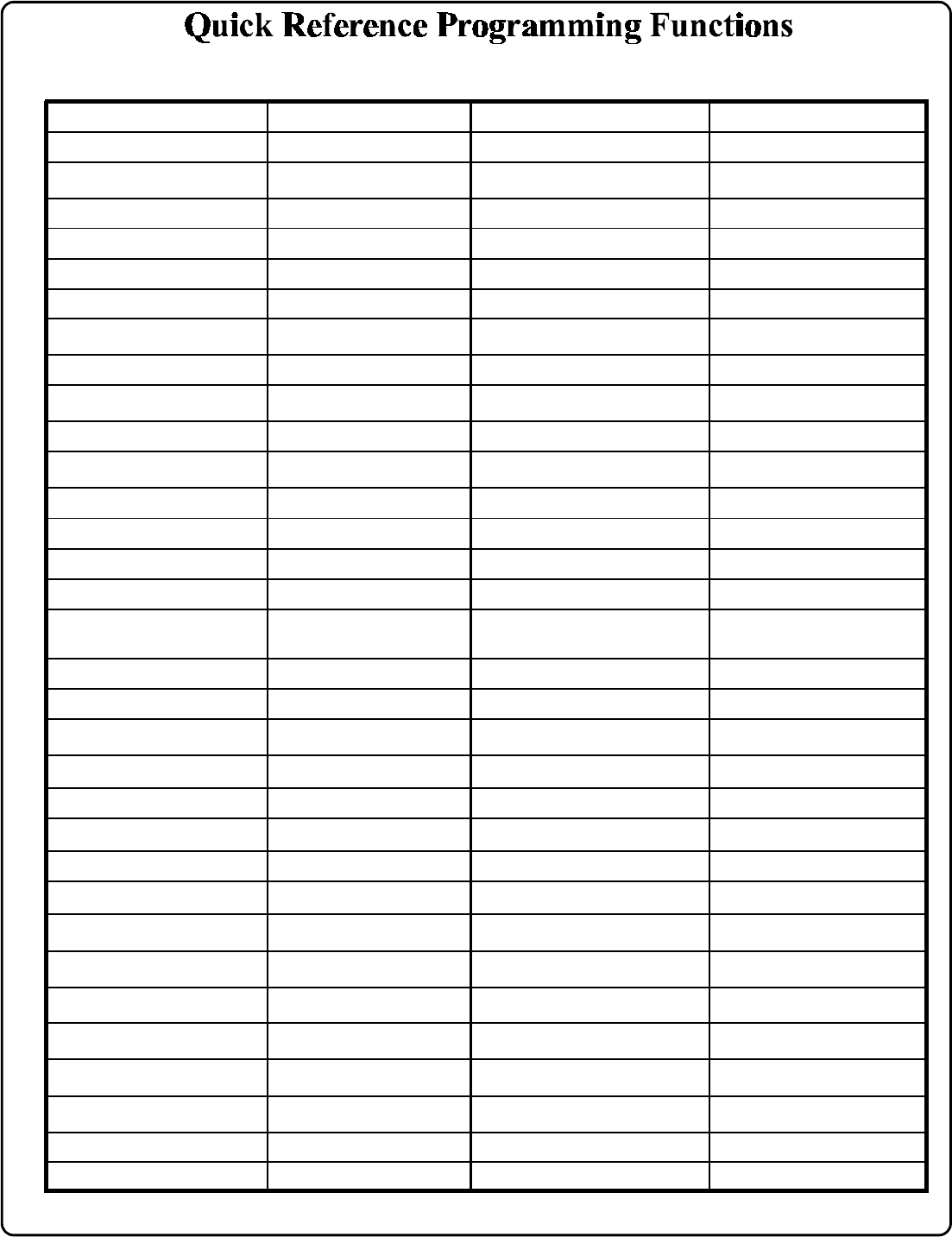
14
For more information on PDL3000 Programming Functions see pages 15 through 28.
; 1 New Master Code ; 4 8 Enable Passage Mode
; 2 Add/Delete/Change User Codes ; 5 0 Disable Passage Mode
; 3 User Disable (By User Number) ; 4 9 Return Lock to Normal Passage
Mode Schedule
; 4 User Enable (By User Number) ; 5 1 Passage Mode Configuration
; 5 User Enable with Timeout ; 5 2 - ; 5 4 Pass Time
; 6 Enable Total User Lockout ; 5 5 Print Audit Trail
; 7 Disable Total User Lockout ; 5 6 Print User Code List
; 8 Reserved ; 5 7 Print Clock Settings and Software
Version
; 9 Enable User 300 (Service Code) ; 5 8 Upload/Download PC Data
; 1 0 Erase All Users Except the
Master Code ; 5 9 AL-DTM2 Door Number
; 1 1 Reserved ; 6 0 Number of Attempt Before Lockout
; 1 2 Clear All Schedules and Timeout
Functions ; 6 1 Set the Attempts Lockout Time
; 1 3 Clear All Timeout Functions ; 6 2 - ; 6 3 Reserved
; 1 4 - ; 1 7 Group 1-4 Disable ; 6 4 - ; 6 5 Disable/Enable Remote Input
; 1 8 Disable All Groups ; 6 6 Ambush Code
; 1 9 - ; 2 2 Group 1-4 Enable ; 6 7 Add Relay/System Features
; 2 3 Enable All Groups ; 6 8 Delete All Relay Functions and
System Options added by Function
67
; 2 4 Reserved ; 6 9 - ; 7 0 Enable/Disable Enter Key
; 2 5 - ; 2 8 Group Disable with Timeout ; 7 1 Reserved
; 2 9 Disable All Groups with Timeout ; 7 2 - ; 7 3 Scheduled Enable/Disable
Passage Mode
; 3 0 - ; 3 3 Group Enable with Timeout ; 7 4 - ; 7 7 Schedule Enable Group 1 - 4
; 3 4 Disable All Groups with Timeout ; 7 8 Schedule Enable All Groups
; 3 5 Group Add/Delete Association ; 7 9 - ; 8 2 Schedule Disable Group 1 - 4
; 3 6 - ; 3 7 Reserved ; 8 3 Schedule Disable All Groups
; 3 8 Set Date ; 8 4 - ; 8 7 Quick Schedules - Enable Group
; 3 9 Set Time ; 8 8 Passage Mode
(Open Time Window)
; 4 0 Set Weekday ; 8 9 Passage Mode
(Close Time Window)
; 4 1 Set Daylight Savings Time ; 9 0 Relay Activation
(Open Time Window)
; 4 2 Reserved ; 9 1 Relay Activation
(Close Time Window)
; 4 3 Speed Up Clock ; 9 2 Enable Group 4
(Open Time Window
; 4 4 Slow Down Clock ; 9 3 Enable Group 4
(Close Time Window
; 4 5 - ; 4 6 Passage Mode Enable/Disable ; 9 4 - ; 9 8 Reserved
; 4 7 Timed Passage Mode ; 9 9 Clear All Lock Programming
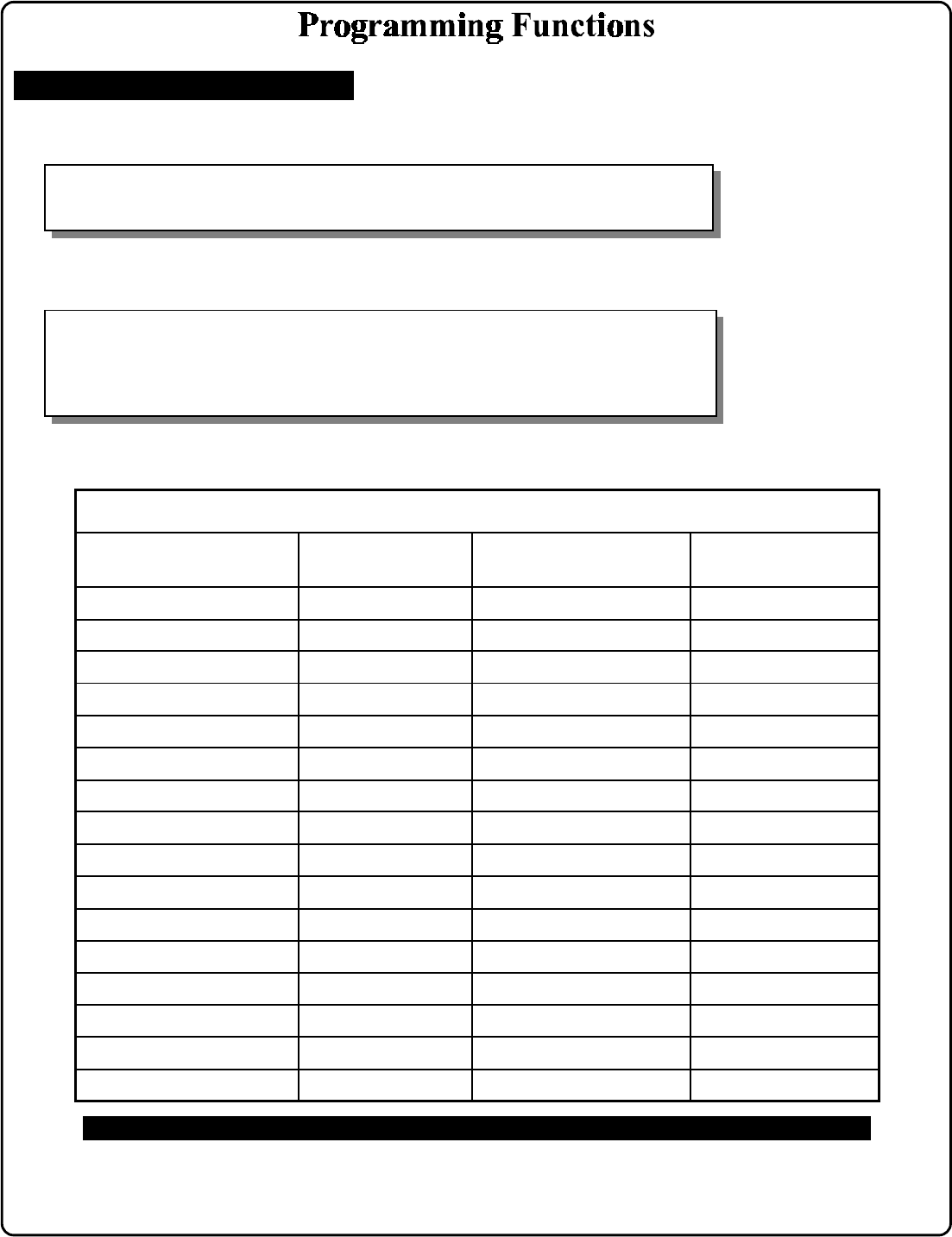
15
1. New Master Code (User Number 1)
2. Add/Delete/Change User Codes 2-2000
; 1 ; [ _ _ _ _ _ _ ] ; [ _ _ _ _ _ _ ] :
(New Master Code) (Confirm New Master Code)
Users programmed with Function 2 will default to a Group
Association and a Program Level Ability as follows:
USER TYPE USER NUMBER GROUP DEFAULT
ASSOCIATION
PROGRAM
LEVEL ABILITY
Master Code 1-1, 2, 3, 4, Master
Installer Codes 2 & 3 none 1, 2, 3, 4
Manager Codes 4 - 6 none 1, 2, 3
Supervisor Codes 7 - 9 none 1, 2
Print Only Codes 10 - 11 none 1
Basic User Codes 12 - 50 none none
Basic User Codes Group 1 51 - 100 1none
Basic User Codes Group 2 101 - 150 2none
Basic User Codes Group 3 151 - 200 3none
Basic User Codes Group 4 201 - 250 4none
Basic User Codes 251 - 296 none none
Quick Enable User 300 Code 297 none none
Quick PC Access Code 298 none none
AL-DTM2 Code 299 none none
Service Code 300 none none
Basic User Codes 301-2000 none none
; 2 ; [ _ _ _ _ ] * ; [ _ _ _ _ _ _ ] :
(User Number)
• User Number must be between 2 and 2000.
• To delete a code/card, leave the User Code blank and wait for the rapid beeping to stop
• User Code must be 3-6 digits.
• Deleting a ProxCard also deletes the associated User Code.
• Master Code must be 6 digits-only.
• Master Code is Keypad Code Access only, Prox Cards and Keyfobs cannot be
programmed as the Master Code.
3
M
USERS
User 299 is a Non-Pass Code. This is the only code that will initiate data transfer with the AL-DTM2.
NOTE:
* To Program ProxCard, enter
: AND Present ProxCard.
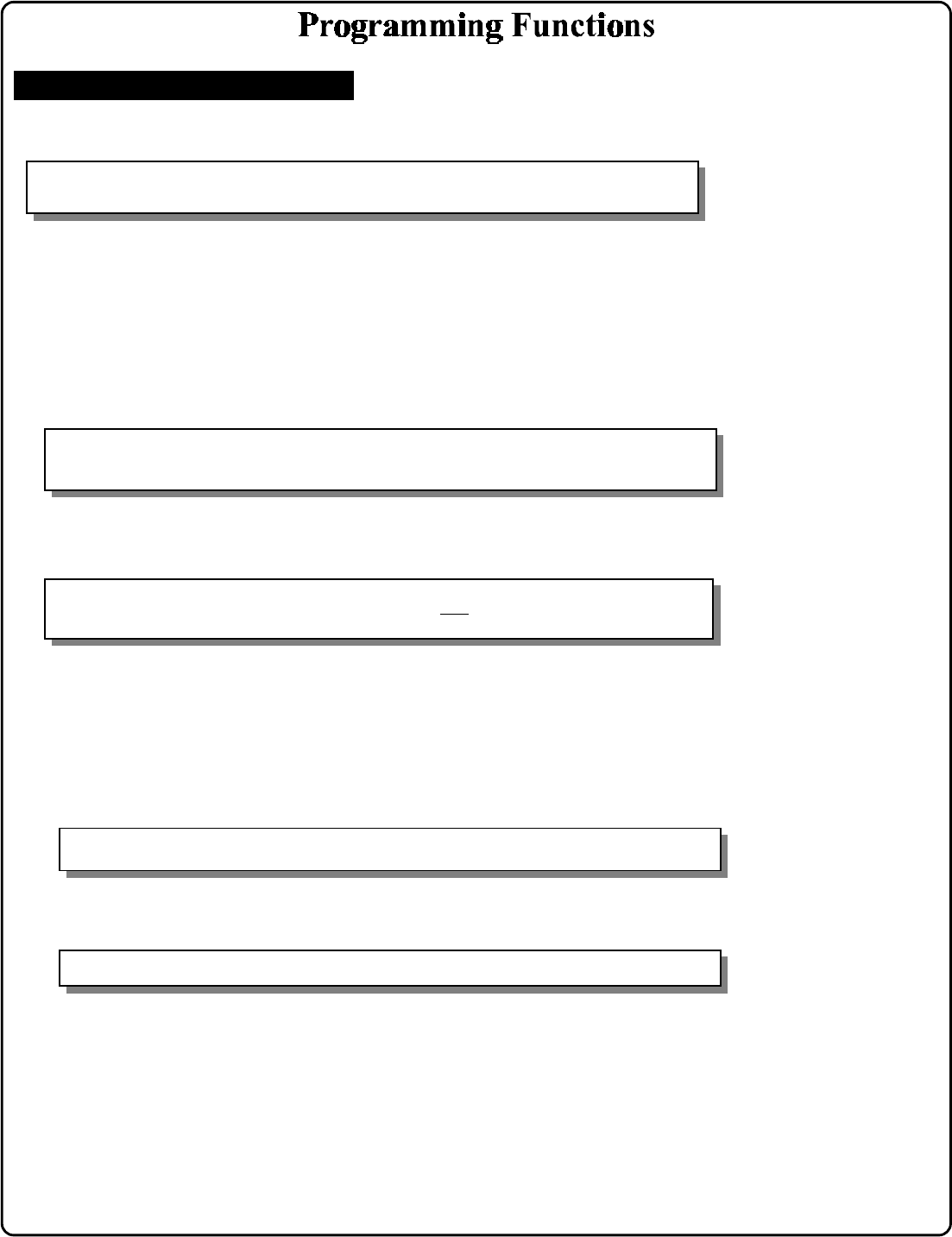
16
USERS (Continued)
; 6 :
6. Enable Total User
7. Disable Total User Lockout ; 7 :
User Lockout Mode
Enables/Disables all User Codes (Except User 1 Code) from operating the lock. Note: No other
programming functions or schedules will re-enable users. Users must be re-enabled with function 7 M
5. User Enable with Timeout
(Enter Timeout, XXX Hours)
; 5 ; [ _ _ _ _ ] ; [ _ _ _ _ ] :
(User Number) (XXX Hours)
• User Numbers must be between 2-2000.
• Hours must be between 1 - 999.
• Can override a disabled user.
2
; 1 0 ; 0 0 0 :
10. Erase All Users Except the Master
Service Code is a One-Time-Only Code. Once it is used, it is disabled until enabled again.
NOTE: User Number 297 can also be used to reset Service Code Use.
; 9 :
9. Enable User 300 (Service Code)
Erases all user codes except the Master Code (User 1).
2
M
11. Reserved
3. Disable User ; 3 ; [ _ _ _ _ ] :
(User Number)
4. Enable User ; 4 ; [ _ _ _ _ ] :
(User Number)
User Enable/Disable (By User Number)
• User Number must be between 2 and 2000.
NOTE: Will Enable/Disable users even if the user is associated with an enabled group. 2
8. Reserved
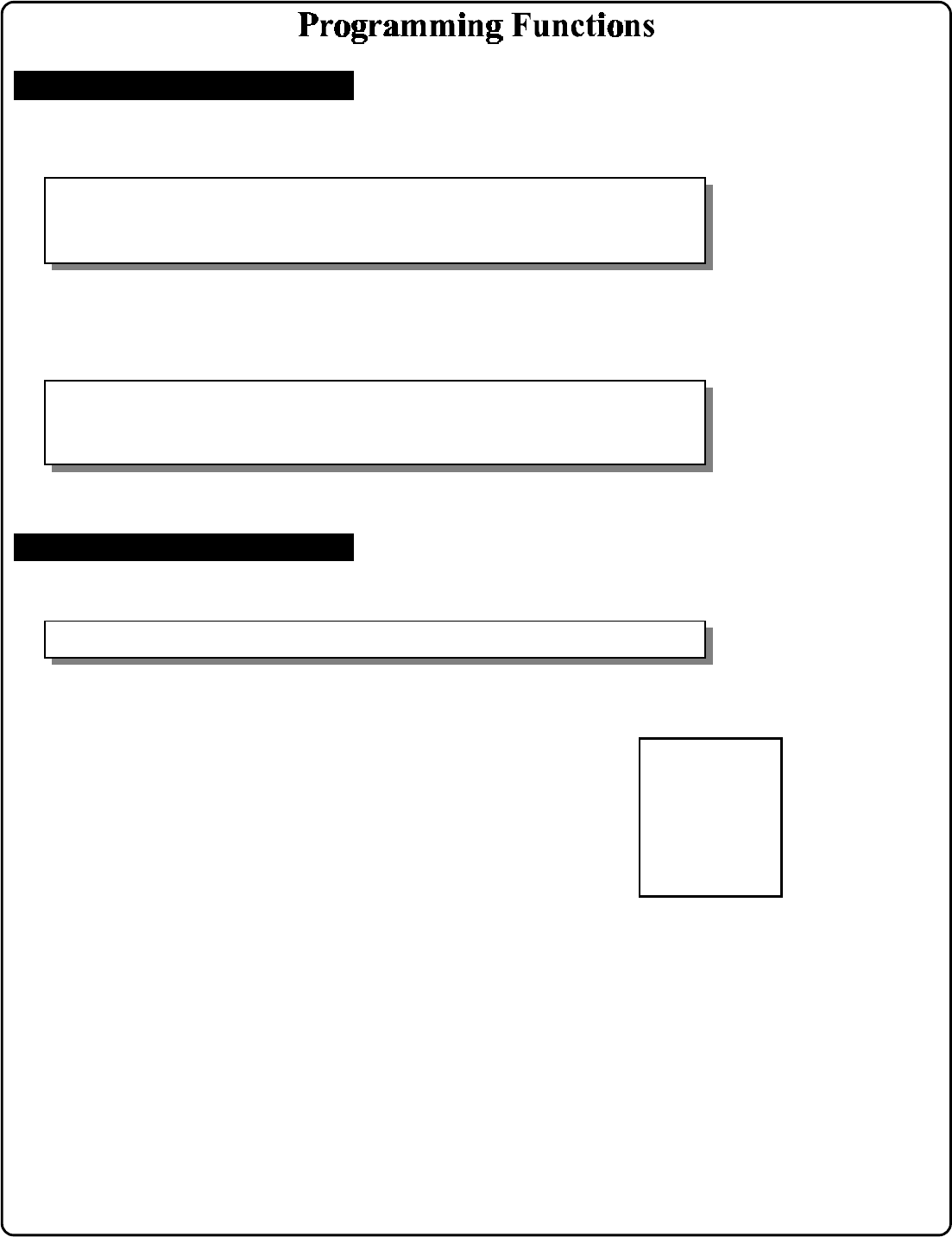
17
; 1 2 ; 0 0 0 :
12. Clear All Schedules and Timeout
; 1 3 ; 0 0 0 :
Clears all programmed Timeout Functions. Includes functions 5, 25 to 34 and Function 47.
NOTE: Only 4 Timeout Functions are allowed at any one time. An error beep will sound when
attempting to program more than 4 Timeout Functions. Scheduled/Timeout features must be manually
reset.
Clears all programmed Schedules and all Timeout Functions. Includes Schedule Functions 72 to 93.
Includes Timeout Functions 5, 25 to 34 and Function 47. NOTE: Up to 4 Timeout Functions may
be pending at any one time. An error beep will sound when attempting to program more than 4
Timeout Functions. Scheduled/Timeout features must be manually reset.
3
3
13. Clear All Timeout Functions
CLEAR FUNCTIONS
; 1 4 :
Group Enable/Disable
; 1 5 :
16. Disable Group 3 ; 1 6 :
17. Disable Group 4 ; 1 7 :
18. Disable All Groups ; 1 8 :
19. Enable Group 1 ; 1 9 :
20. Enable Group 2 ; 2 0 :
21. Enable Group 3 ; 2 1 :
22. Enable Group 4 ; 2 2 :
23. Enable All Groups ; 2 3 :
Enter the functions below to Enable/Disable Groups.
14. Disable Group 1
15. Disable Group 2
2
GROUPS
24. Reserved
1. Disabled Users
2. Enabled Groups
3. Disabled Groups
4. Enabled Users
Priority Order
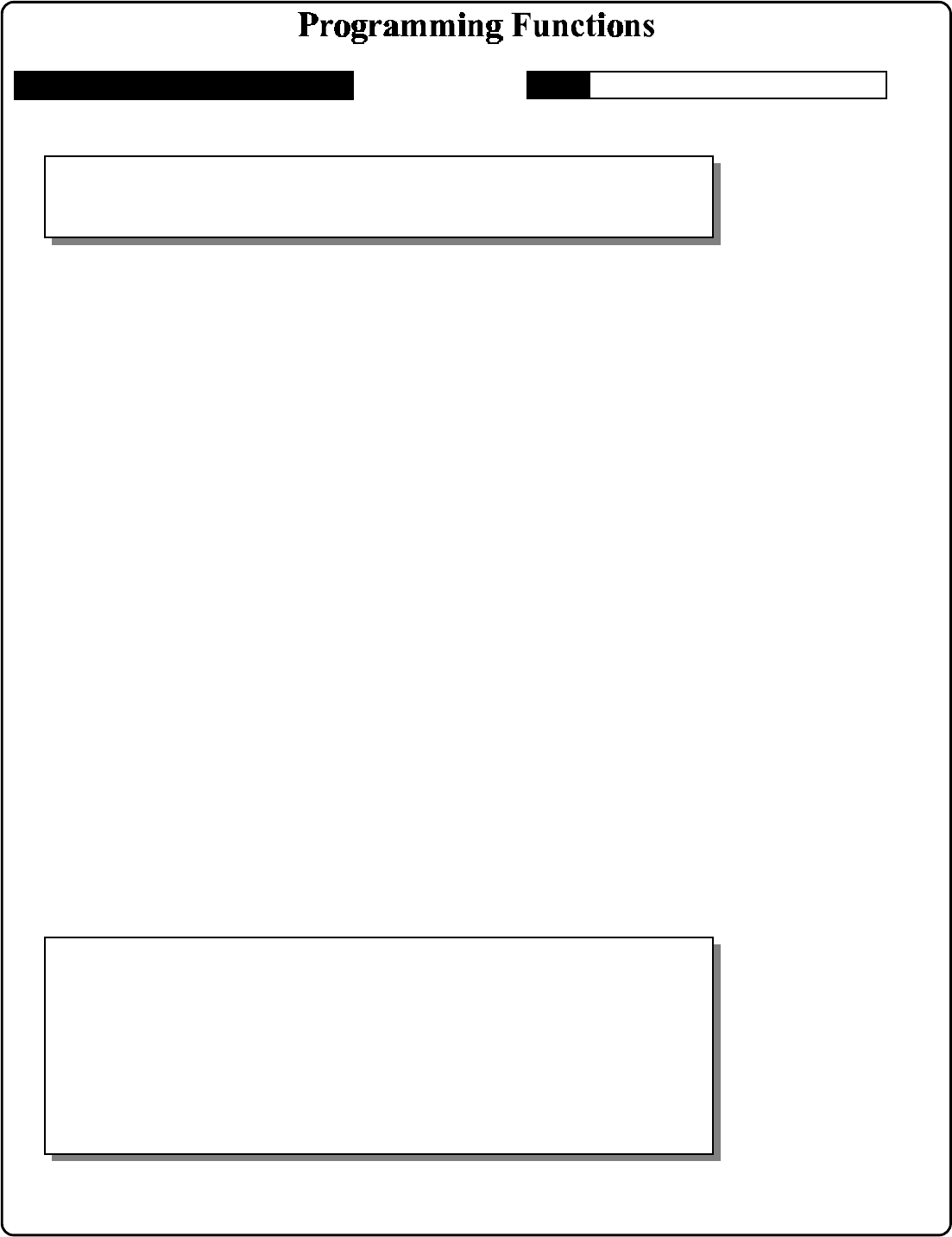
18
GROUPS
; 2 5 ; [ _ _ _ ] :
(XXX Hours)
25. Timed Disable Group 1
Group Enable/Disable with Timeout (Enter Timeout, XXX Hours)
• Hours must be between 1 - 999.
Enter the functions below to Enable/Disable groups for the amount of time entered in hours.
NOTE: Only 4 Timeout Functions are allowed at any one time. An error beep will sound
when attempting to program more than 4 Timeout Functions.
2
; 3 5 ; [ _ _ _ ] ; [ _ _ _ _ ] :
(User Number) (Groups)
35. Group Add/Delete Association
• Groups that are not Selected are then Disassociated from the User (See Group Default
Association on page 15).
• User Number must be between 2 and 2000.
• 1 or more (1-4) groups to associate with user may be selected.
Add Example: To associate user 67 with groups 1, 2 and 4;
Enter: ; 3 5 ; 6 7 ; 1 2 4 :
Delete Example: To remove all group associations for user 67;
Enter: ; 3 5 ; 6 7 :
NOTE: If a user is associated with more than one group, all associated groups would have
to be disabled before the user is disabled.
; 2 6 ; [ _ _ _ ] :
(XXX Hours)
26. Timed Disable Group 2
; 2 7 ; [ _ _ _ ] :
(XXX Hours)
27. Timed Disable Group 3
; 2 8 ; [ _ _ _ ] :
(XXX Hours)
28. Timed Disable Group 4
; 2 9 ; [ _ _ _ ] :
(XXX Hours)
29. Timed Disable All Groups
; 3 0 ; [ _ _ _ ] :
(XXX Hours)
30. Timed Enable Group 1
; 3 1 ; [ _ _ _ ] :
(XXX Hours)
31. Timed Enable Group 2
; 3 2 ; [ _ _ _ ] :
(XXX Hours)
32. Timed Enable Group 3
; 3 3 ; [ _ _ _ ] :
(XXX Hours)
33. Timed Enable Group 4
; 3 4 ; [ _ _ _ ] :
(XXX Hours)
34. Timed Enable All Groups
3
36 - 37. Reserved
Clear All Timeout Functions by entering Function 13.NOTE:
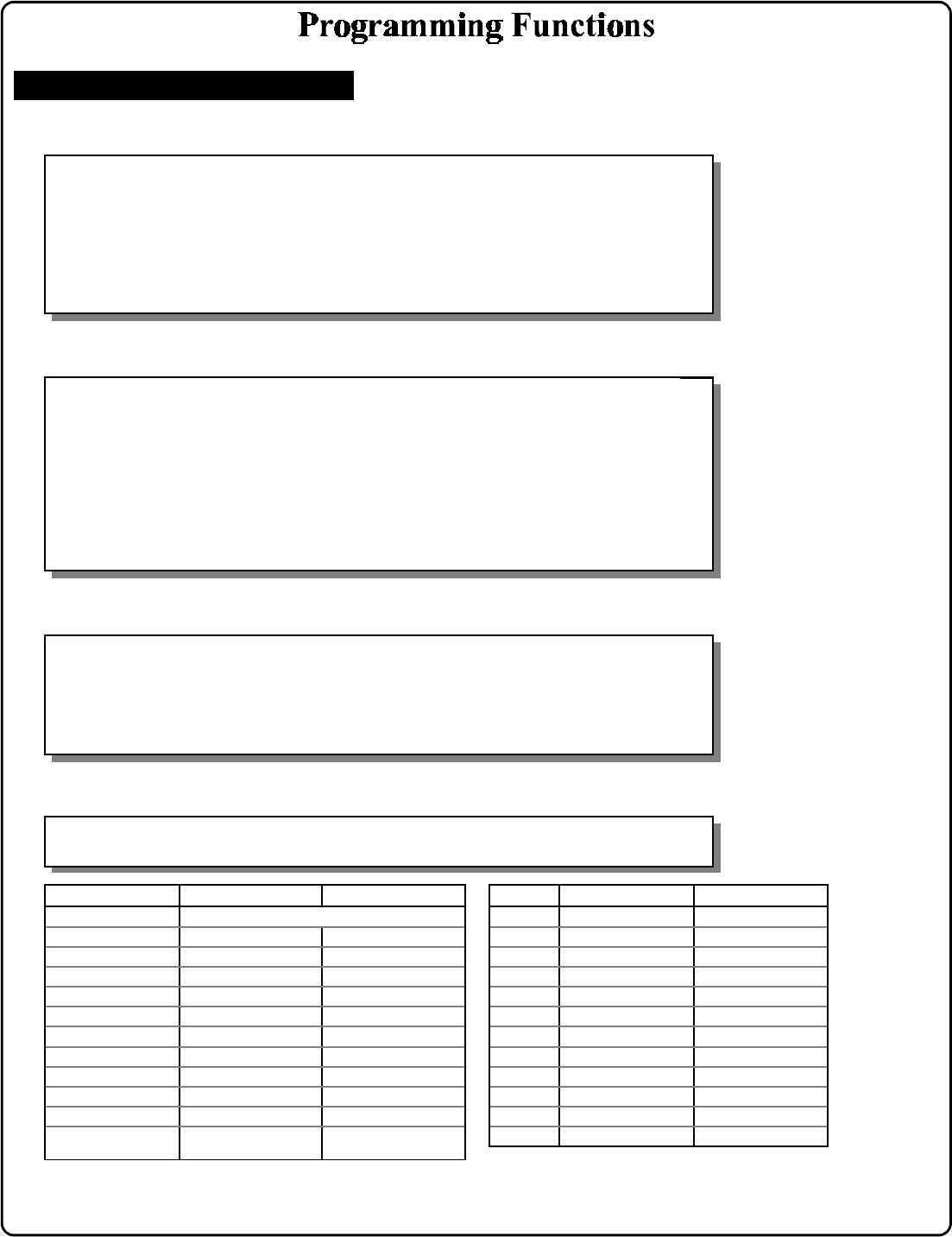
19
; 3 8 ; [ _ _ _ _ _ _ ] :
(Date)
38. Set Date
42. Reserved
• Use Month Day Year format - MMDDYY - Single digit months and days are entered with
a preceding zero.
• Enter Only the last two digits of the year.
For Example: March. 8, 2000;
Enter:
; 3 8 ; 0 3 0 8 0 0 :
3
39. Set Time ; 3 9 ; [ _ _ _ _ ] :
(Time)
• Time must be 4 digits
• Use 24 Hour Format (add 12 hours to program P.M. time)
For Example: To set time to 8:25 P.M.;
Enter: ; 3 9 ; 2 0 2 5 :
For Example: To set time to 8:25 A.M.;
Enter: ; 3 9 ; 0 8 2 5 :
3
; 4 0 ; [ _ ] :
(Day)
40. Set Weekday
• For day enter: 1 for Sunday, 2 for Monday, 3 for Tuesday, 4 for Wednesday, 5 for Thursday, 6
for Friday and 7 for Saturday.
For Example: To set day to Sunday;
Enter: ; 4 0 ; 1 :
3
41. Set Daylight Savings Time ; 4 1 ; [ _ _ ] :
(DST Mode)
NOTE: Daylight Savings Time (DST) Adjustment is programmable as shown in the table below.
All modes adjust time at 2AM. * Default DST Mode is 12. 4
CLOCK SETTINGS
DST Mode Time Forwarded Time Regressed
01 No DST Adjustment
02 1st Sunday in March 4th Tuesday in Sept.
03 Last Sat. in March Last Sat. in Sept.
04 Last Sunday in March Last Sunday in Sept.
05 Last Sunday in March 4th Sunday in Oct.
06 Last Sunday in March Last Sunday in Oct.
07 Last Sunday in March 1st Sunday in Sept.
08 April 1st September 30th
09 April 1st October 1st
10 April 1st Last Sunday in Oct.
11 1st Sunday in April 2nd Sunday in Oct.
* 12 (U.S.A. &
Canada)
1st Sunday in April Last Sunday in Oct.
DST Mode Time Forwarded Time Regressed
13 Last Friday in April Last Thurs. in Sept.
14 May 1st September 30th
15 1st Sunday in Sept. 1st Sunday in April
16 2nd Tuesday in Sept. 3rd Tuesday in April
17 1st Sunday in Oct. Last Sunday in Feb.
18 1st Sunday in Oct. 3rd Sunday in March
19 1st Sunday in Oct. Last Sunday in Mar.
20 2nd Sunday in Oct. 2nd Sunday in Mar.
21 3rd Sunday in Oct. 2nd Sunday in Feb.
22 Last Sunday in Oct. 1st Sunday in March
23 Last Sunday in Oct. Last Sunday in Mar.
24 1st Sunday in Nov. Last Sunday in Feb.
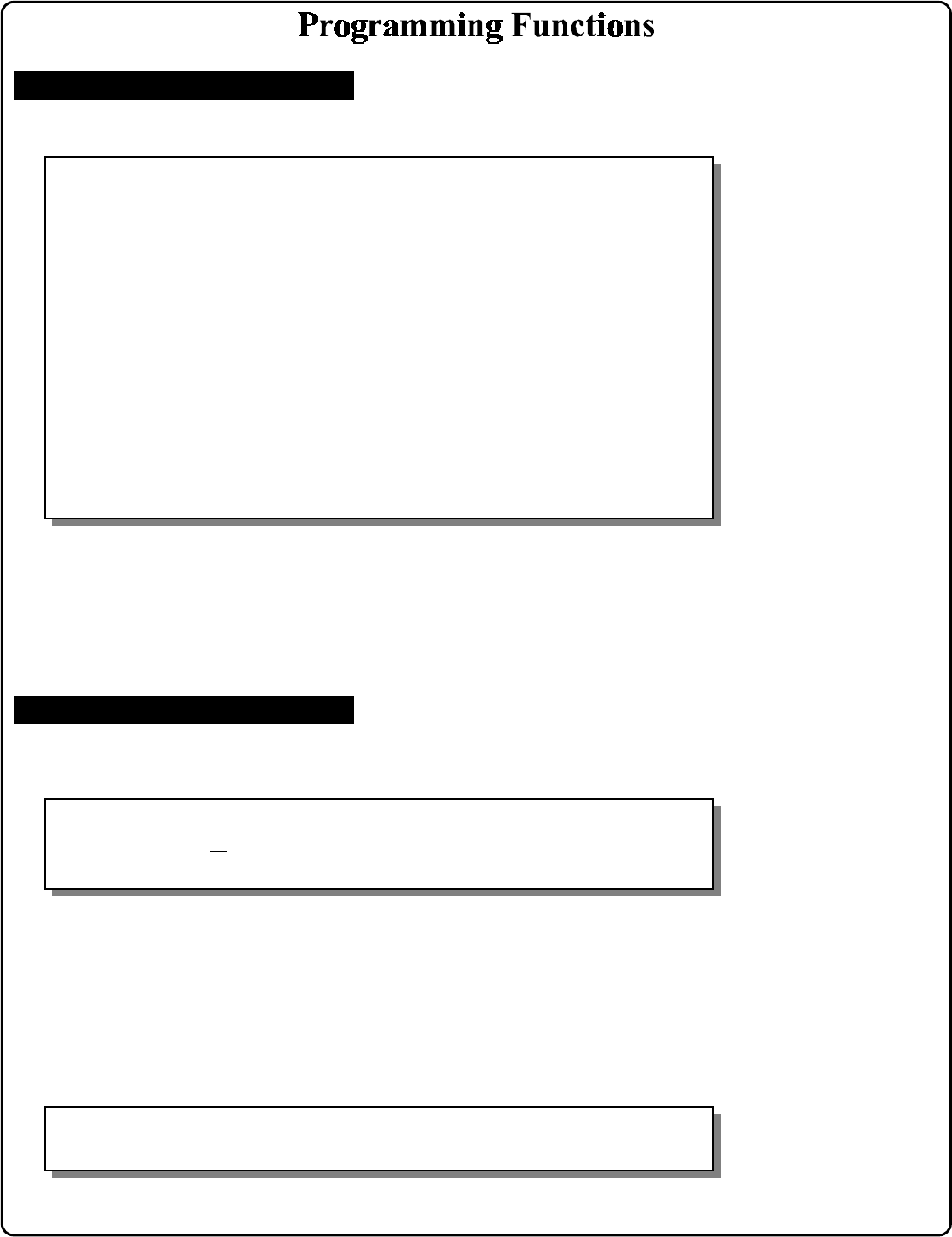
20
CLOCK ADJUST
; 4 3 ; [ _ _ ] :
(seconds)
43. Speed Up Clock
; 4 4 ; [ _ _ ] :
(seconds)
44. Slow Down Clock
• Number of seconds to Speed Up/Slow Down clock each day must be 0-55 seconds.
Always consider the current setting when using this function. (Use of this function is not
cumulative.) For example, if the clock needs to be sped up 10 seconds per day and the
current setting is 10, program 20 seconds using Function 43.
Example 1: Clock is losing 13 seconds every day, enter:
; 4 3 ; 1 3 :.
This example assumes that the clock adjust setting was at the factory default of zero.
Function 57 can be used to print the current clock adjust setting.
Example 2: Clock is gaining 13 seconds every day, enter:
; 4 4 ; 1 3 :.
This example assumes that the clock adjust setting was at the factory default of zero.
Function 57 can be used to print the current clock adjust setting.
Example 3: To set the clock adjust setting back to the factory default of zero, enter:
; 4 3 : or ; 4 4 :
Clock Adjust
4
; 4 5 :
45. Enable Passage Mode
; 4 6 :
46. Disable Passage Mode
47. Timed Passage Mode ; 4 7 ; [ _ _ _ ] :
(XXX Hours)
• Allows passage through the door without the need for a code using Function 45. Re-
Lock using Function 46.
• Programmed Schedules will override the state of the lock using Functions 45 and 46. If it
is required that programmed schedules do not override passage mode, Enable/Disable
Passage Mode Enable/Disable - Schedule will Override
2
• Hours must be between 1 - 999.
Allows passage through the door without the need for a code for the programmed amount
of time.
2
PASSAGE MODE
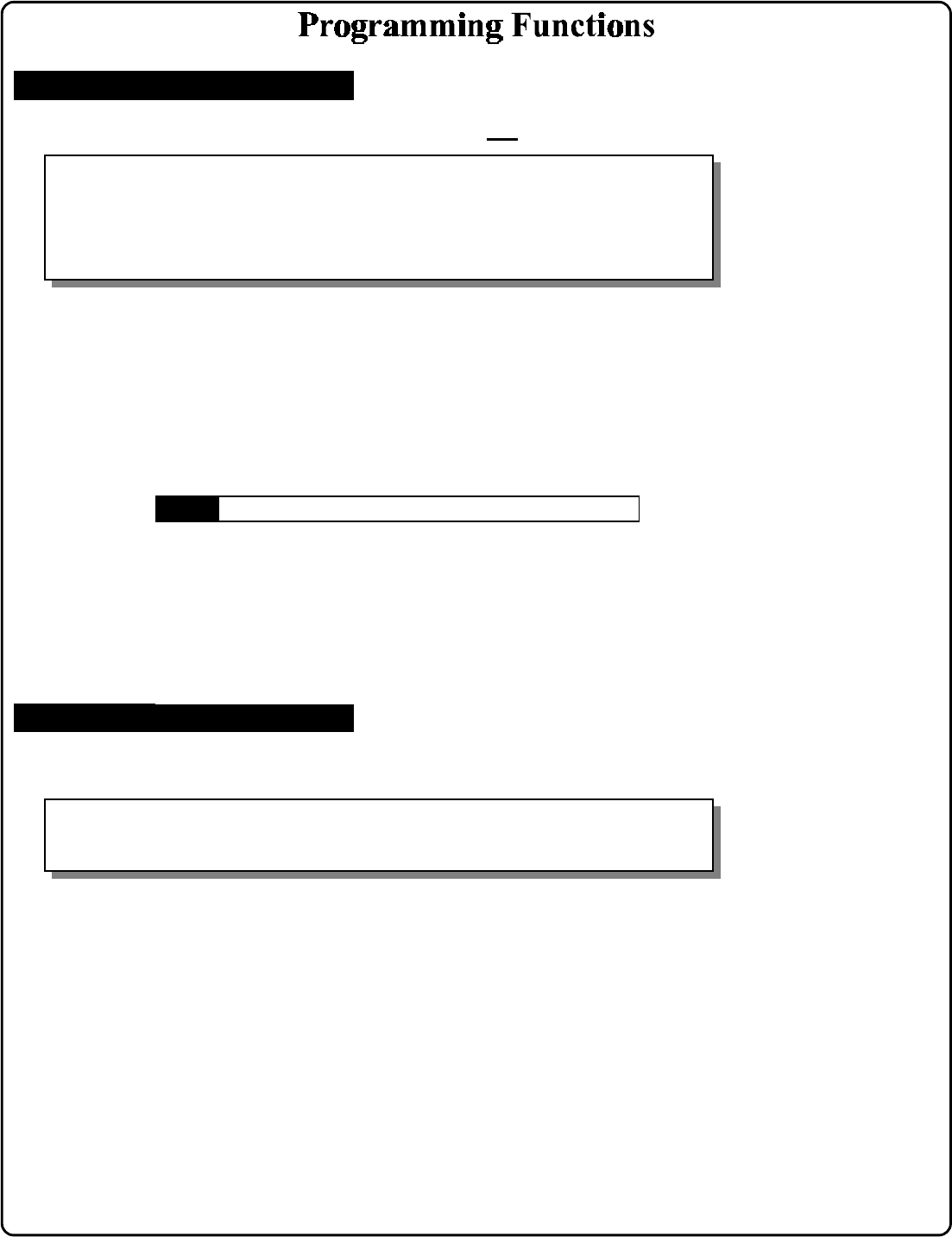
21
49. Disable Passage Mode
50. Return Lock to Normal
Passage Mode Schedule
(The PDL3000 will lock or unlock
depending on the current schedule.)
• Allows passage through the door without the need for a code using Function 48. Re-Lock
using Function 49.
• Programmed Schedules will not override the state of the lock using functions 48 and 49.
If it is required that programmed schedules do override passage mode, Enable/Disable
Passage mode using Functions 45/46. Use Function 50 to return the lock to scheduled
functions.
Passage Mode Enable/Disable - Schedule will not Override
2
PASSAGE MODE
; 4 9 :
48. Enable Passage Mode ; 4 8 :
; 5 0 :
; 5 2 :52. Set Pass Time to 3 Sec.
; 5 3 :
; 5 4 :
Use the functions below to change the pass time to 3, 10 or 15 seconds. The Pass Time is
defaulted to 3 seconds. The Pass Time is the time the lock stays unlocked after a User
Code is entered.
Pass Time
4
53. Set Pass Time to 10 Sec.
54. Set Pass Time to 15 Sec.
PASS TIME
See Scheduled functions 72 and 73 for scheduled passage mode.
NOTE:
51. Passage Mode Configuration ; 5 1 ; [ _ ] :
(Mode)
Mode 1 (Normal): Passage mode must be enabled/disabled using Function 45 and 46.
Mode 2: Group 2 toggles passage mode.
Mode 3: Group 2 enables, Group 3 disables passage mode *
* Disable passage mode has priority if user is a member of both Groups 2 and 3.
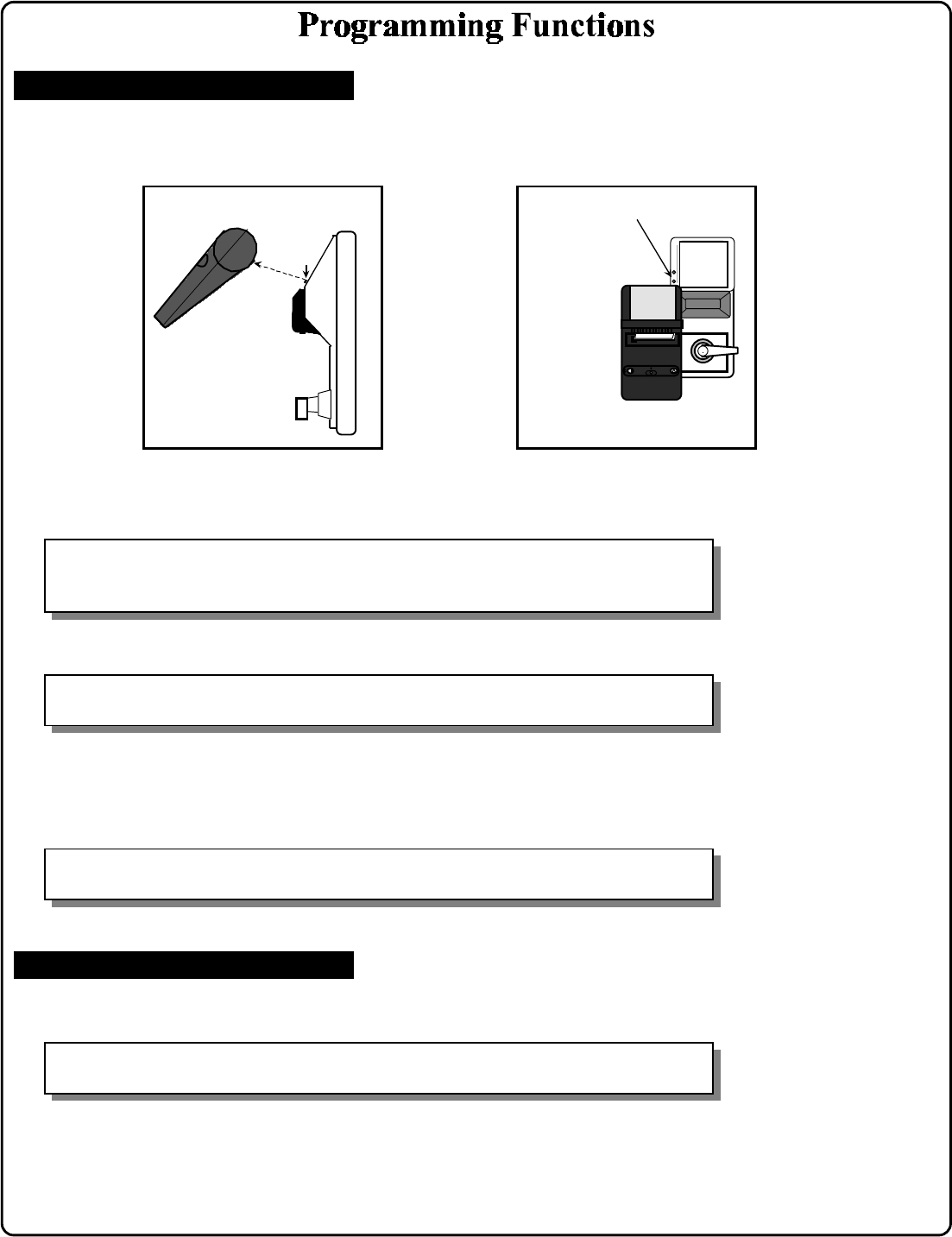
22
; 5 5 :
; 5 7 :
57. Print Clock Settings and Software
Version
55. Print Audit Trail
; 5 6 :
56. Print User Code List
; 5 8 :
58. Upload/Download PC Data
Hold the printer over the lock's infrared sensor as shown in Figure 1 and Figure 2. Twenty
(20) events will print at a time; press 1 for more events, or 9 to quit. To abort printing,
press any key for 3 Sec (Three short beeps will sound).
Hold the printer over the lock's infrared sensor as shown in Figure 1 and Figure 2. To
abort printing, press any key for 3 Sec (Three short beeps will sound).
Hold the printer over the lock's infrared sensor as shown in Figure 1 and Figure 2.
For use with DL-WINDOWS software, refer to OI237. AL-PCI interface cable is needed.
1
3
3
PRINTER
DOWNLOADING
Hold the printer perpendicular to the Lock’s infrared LED as shown in Figure 1 and Figure 2. If
the printer has been idle for some time, press the paper feed button to wake up printer.
1
Infrared
LED
PDL3000 to Printer - Front View
123
456
789
:0;
Figure 2
Infrared
LED
PDL3000 to Printer
- Side View
Figure 1
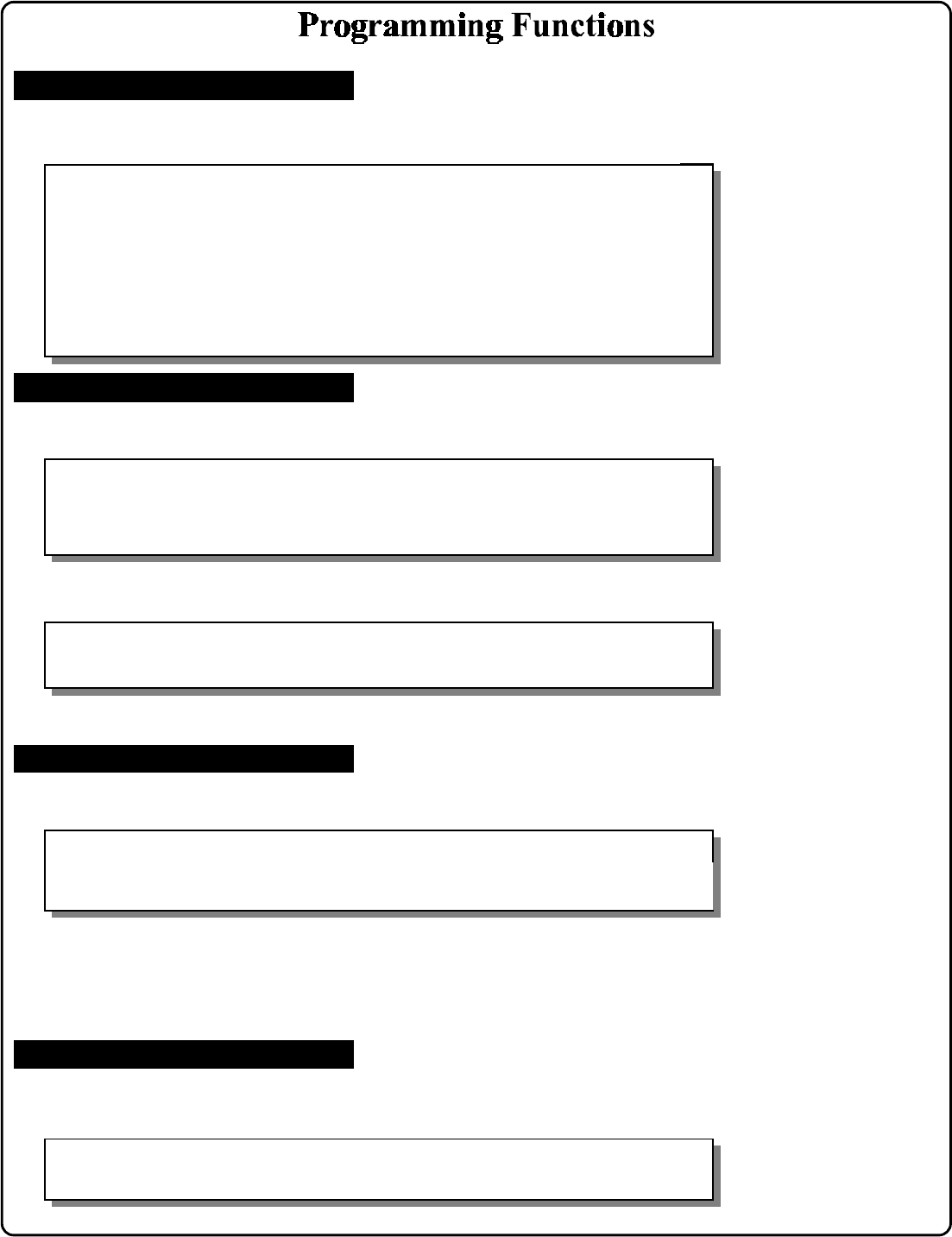
23
60. Number of Attempts Before Lockout
61. Set the Attempts Lockout Time
• Number of attempts before lockout must be 1-9 attempts.
• The number of attempts is reduced by half every time the keypad is locked out without a
successful code entry (default is 6 attempts).
• The attempt count is reset each time a valid code is entered.
• Lockout Time must be 1-60 seconds.
How long the keypad is locked out after a series of unsuccessful attempts (default is 15
seconds).
4
4
LOCKOUT
; 6 4 :
64. Disable Remote Input
• Wire a Normally Open Contact to Wires (White & White). Momentarily close to allow person to pass
through door.
• Enter the functions below to Disable/Enable the Remote Input.
NOTE: The Remote Input is enabled as part of the default program.
Remote Input
; 6 5 :
65. Enable Remote Input
; 6 6 ; [ _ _ ] :
(Ambush Code)
66. Ambush Code
• Ambush code must be 2 digits.
• An error will sound if the ambush code matches the 1st two digits of any user code. See
Using Ambush Function on page 6.
2
3
REMOTE INPUT
AMBUSH
; 6 0 ; [ _ ] :
(Number of Attempts)
; 6 1 ; [ _ _ ] :
(Lockout Time)
62-63. Reserved
59. AL-DTM2 Door Number
• Door Number must be between 1- 96. Note: Door Number must be between 1-48 for
AL-DTM (Version 1).
For use with Alarm Lock’s AL-DTM2 Data Transfer Module. Using the AL-DTM2 up to
96 locks can be Downloaded/Uploaded and History LOGs can be retrieved. Enter a door
number for each lock. After configuring the AL-DTM2, using Alarm Lock's DL-
WINDOWS Software, any of the following data transfers can be initiated by plugging the
AL-DTM2 into the lock and simply entering User Code 299 at the lock.
• Upload Lock Program
• Upload History LOG
• Download Lock Program
4
AL-DTM2
; 5 9 ; [ _ _ ] :
Door Number)
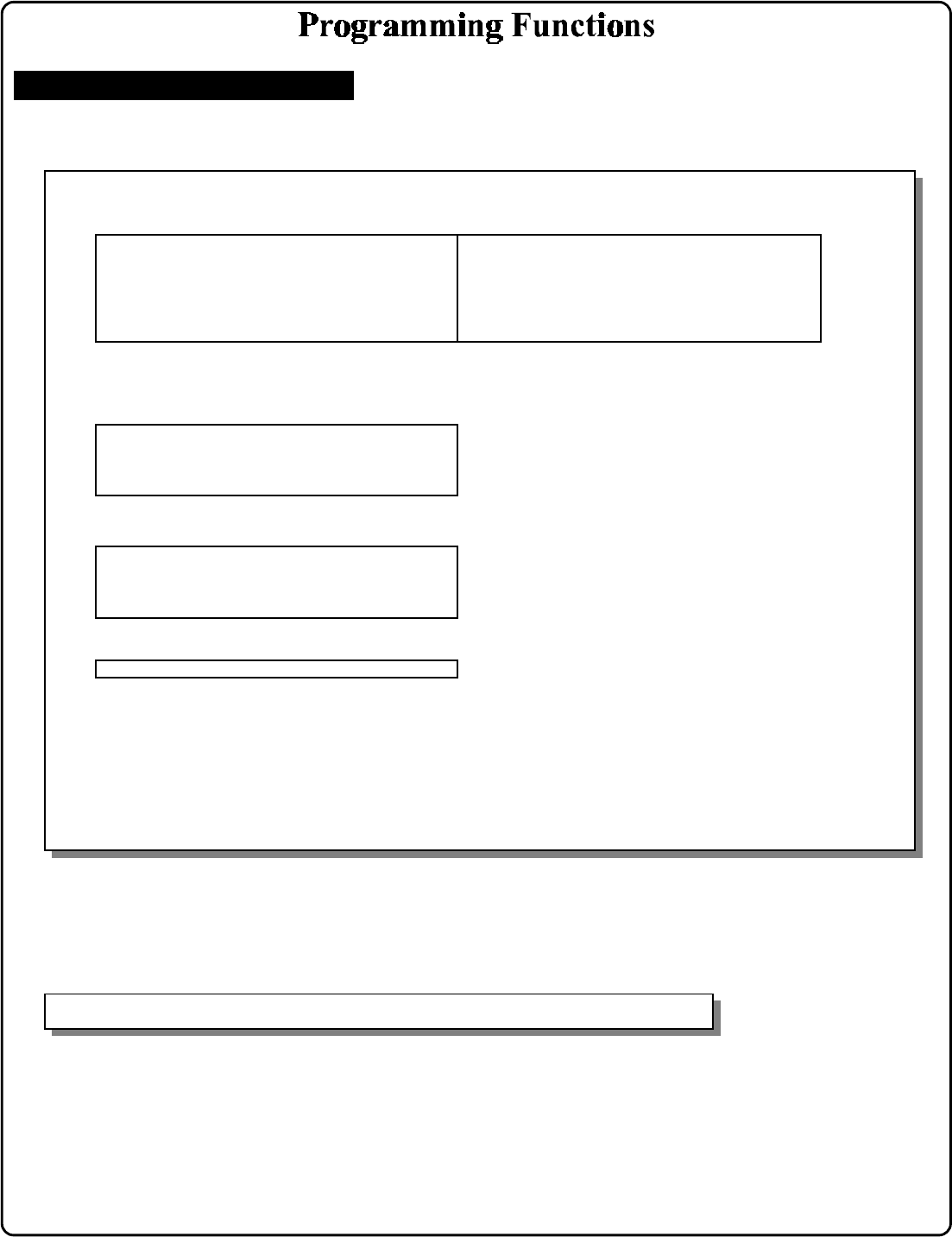
24
12-24. Reserved
; 6 7 ; [ _ _ ] :
(Relay Function / System Feature)
67. Add Relay/System Features
RELAY / SYSTEM FEATURES
68. Delete All Relay Functions and
System Options added by Function 67
; 6 8 ; 0 0 0 :
Delete all Relay Functions programmed by Function 67.
• Relay Functions
Program 1 or more events below to activate the Relay for 2 seconds.
1. Remote Input while enabled 7. Locked by Schedule
2. Remote Input while disabled 8. Unlocked by Schedule
3. Failed Entry Attempt 9. Lock Out
4. Disabled User entered code/card 10. Ambush Tripped
5. Access Granted 11. Any key press/card entry
6. Scheduled (Group 1 Activated) Function 90 31. Relay Follows Lock/Unlock Status **
4
• System Options
25. Disable Sounder
26. 5 sec. Delayed Entry *
27. 15 sec. Delayed Entry *
28. 45 sec. Delayed Entry *
• Remote Input Functions
29. Remote Input Toggles Passage Mode
30. Forced Unlock Follows Remote Input **
32. Remote Input Disables Unit (Hold all States)
34. Forced Lock Follows Remote Input **
* Features 26, 27 & 28 delay users 12 and greater only, except 297, 298 and 299.
** Features 30, 31, 32 & 34 should be used with External DC Power unless feature is used for short a duration and
infrequently (sustained closure of remote input or relay will drain batteries. Scheduled events will not occur during
sustained closure of remote input). Sustained closure of remote input may affect proper audit trail operation.
• PC Communication Functions
33. Remote Input Puts Unit in PC Communication Mode
4
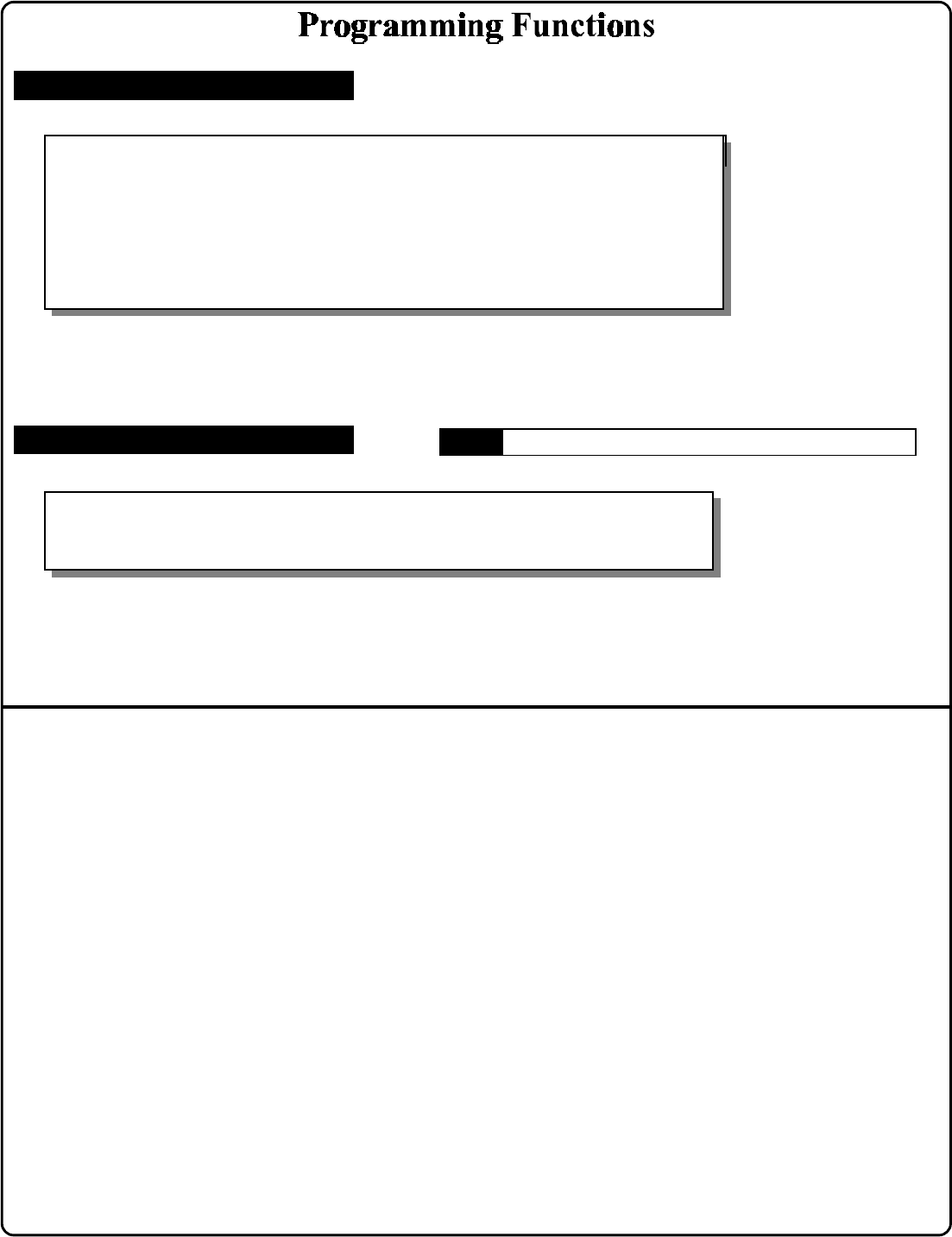
25
Scheduled Passage and Group
Use the functions below to Enable/Disable Groups at the time programmed.
• For day enter: 1 for Sunday, 2 for Monday, 3 for Tuesday, 4 for Wednesday, 5 for
Thursday, 6 for Friday and 7 for Saturday, 8 for Monday to Friday, 9 for Saturday and
Sunday, 0 for all days of week.
SCHEDULES
74. Schedule Enable Group 1 ; 7 4 ; [ _ ] ; [ _ _ _ _ ] :
(Day) (Time)
75. Schedule Enable Group ; 7 5 ; [ _ ] ; [ _ _ _ _ ] :
(Day) (Time)
76. Schedule Enable Group ; 7 6 ; [ _ ] ; [ _ _ _ _ ] :
(Day) (Time)
77. Schedule Enable Group ; 7 7 ; [ _ ] ; [ _ _ _ _ ] :
(Day) (Time)
78. Schedule Enable All
Groups ; 7 8 ; [ _ ] ; [ _ _ _ _ ] :
(Day) (Time)
79. Schedule Disable Group 1 ; 7 9 ; [ _ ] ; [ _ _ _ _ ] :
(Day) (Time)
80. Schedule Disable Group 2 ; 8 0 ; [ _ ] ; [ _ _ _ _ ] :
(Day) (Time)
81. Schedule Disable Group 3 ; 8 1 ; [ _ ] ; [ _ _ _ _ ] :
(Day) (Time)
82. Schedule Disable Group 4 ; 8 2 ; [ _ ] ; [ _ _ _ _ ] :
(Day) (Time)
83. Schedule Disable All
Groups ; 8 3 ; [ _ ] ; [ _ _ _ _ ] :
(Day) (Time)
3
Clear All Schedule and Timeout Functions by entering Function 12.
NOTE:
72. Schedule Enable Passage
Mode (Unlock)
; 7 2 ; [ _ ] ; [ _ _ _ _ ] :
(Day) (Time)
73. Schedule Disable Passage
Mode (Lock) ; 7 3 ; [ _ ] ; [ _ _ _ _ ] :
(Day) (Time)
Groups
ENTER KEY
• When this function is enabled the user must press the : key after any valid User Code entry;
allows user codes which are subsets of other user codes.
Example:
1 2 3 : is a valid user code;
1 2 3 4 : is a valid user code
1 2 3 4 5 6 : (hold ; ) for Master User Code to enter Program Mode.
Enter Key
4
71. Reserved
Passage
Mode
69. Enable : as Enter Key
70. Disable : as Enter Key
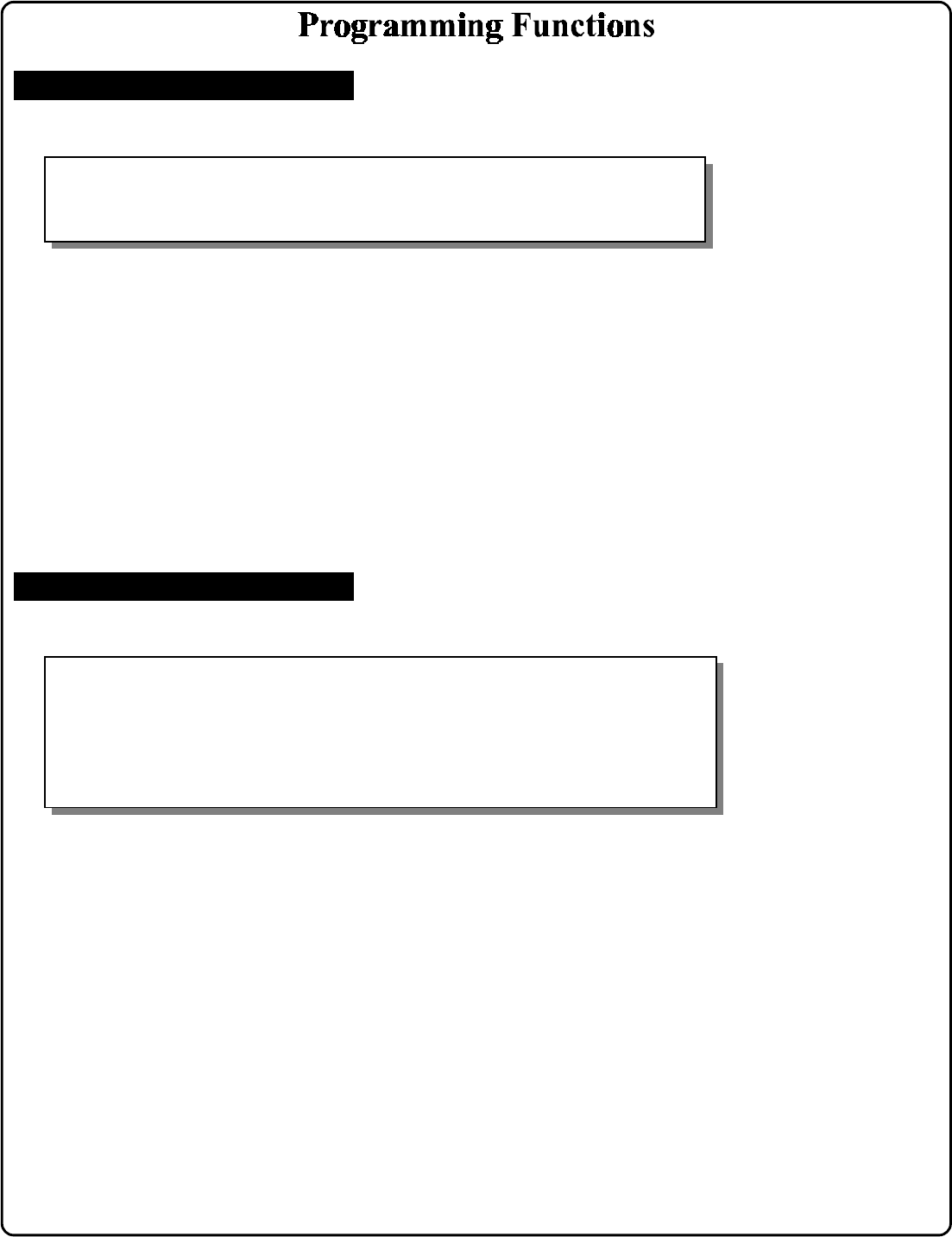
26
; 8 5 ; [ _ ] :
(Group)
; 8 7 ; [ _ ] :
(Group)
; 8 6 ; [ _ ] :
(Group)
84. Business Quick Schedule
7AM-5PM, Monday - Friday
; 8 4 ; [ _ ] :
(Group)
QUICK SCHEDULES
85. Day Quick Schedule
7AM-5PM, All days
86. Evening Quick Schedule
3PM-1AM, All days
87. Night Quick Schedule
11PM-9AM, All days
88. Passage Mode
(Open Time Window)
; 8 8 ; [ _ ] ; [ _ _ _ _ ] :
(Day) (Time)
• For day enter: 1 for Sunday, 2 for Monday, 3 for Tuesday, 4 for Wednesday, 5 for
Thursday, 6 for Friday and 7 for Saturday, 8 for Monday to Friday, 9 for Saturday and
Sunday, 0 for all days of week.
• Enter time of day in 24 hour format.
Enter the Open and Close Window Functions below to set up a Window where if any Group
1 User Code is entered within the programmed window, Passage Mode will be activated.
See Group 1 Member in Puts Lock in Passage Mode on page 6.
Scheduled Passage Mode (Group 1 Activated)
89. Passage Mode
(Close Time Window)
; 8 9 ; [ _ ] ; [ _ _ _ _ ] :
(Day) (Time)
SCHEDULES GROUP 1 ACTIVATED
3
• Group number must be 1-4
Enter the number of the group that is to be enabled for the time specified for the Quick
Schedules below:
3
Quick Schedules - Enable Group
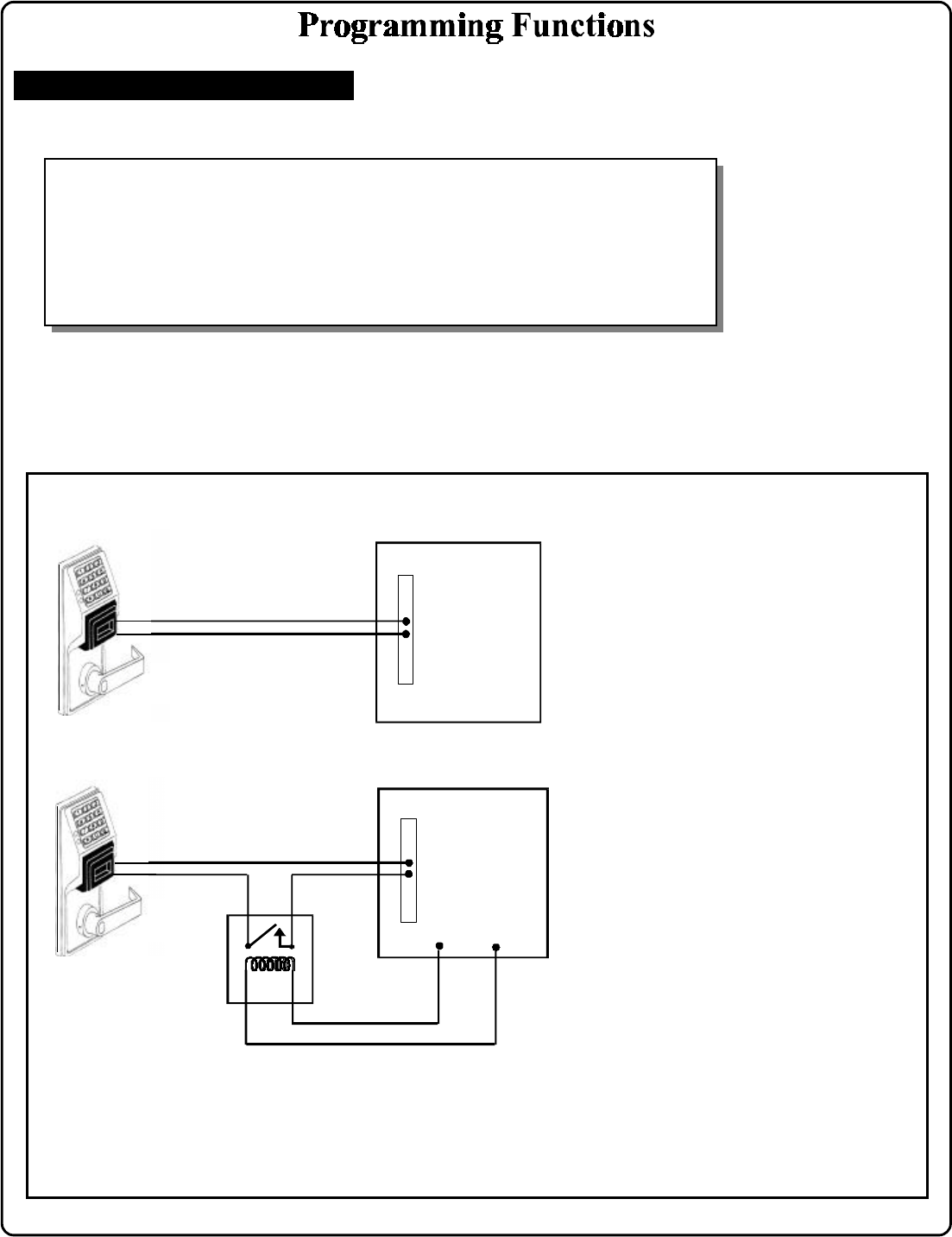
27
To Disarm a Burglary Control Panel
90. Relay Activation
(Open Time Window)
; 9 0 ; [ _ ] ; [ _ _ _ _ ] :
(Day) (Time)
• Also program Relay Function 6 using Function 67 (; 6 7 ; 6 :).
• For day enter: 1 for Sunday, 2 for Monday, 3 for Tuesday, 4 for Wednesday, 5 for
Thursday, 6 for Friday and 7 for Saturday, 8 for Monday to Friday, 9 for Saturday and
Sunday, 0 for all days of week.
• Enter time of day in 24 hour format.
Enter the Open and Close Window Functions below to set up a Window where if any Group
1 User Code is entered within the programmed window the relay will be activated for 2
seconds. For use with a Control Panel that has a key switch disarm option. See Disarming
a Burglar Alarm on page 6.
Scheduled Relay Activation (Group 1 Activated)
; 9 1 ; [ _ ] ; [ _ _ _ _ ] :
(Day) (Time)
91. Relay Activation
(Close Time Window)
SCHEDULES GROUP 1 ACTIVATED
3
Burglary
Control
Panel
Relay
OutputSwitch
Input
Alarm Panel with Switched Input for Disarming
Burglary
Control
Panel
Relay
OutputSwitch
Input
External
Relay
Armed
Lug
Power
Alarm Panel with Switched Input for Toggled Arm/Disarm
Notes:
1. Group 1 Disarms a Burglary Control
Panel will always disarm an alarm system.
Arming should be performed by other
means (such as Alarm Panel Keypad/
Schedule).
2. Use a qualified electrical/alarm specialist
to review your current alarm system and
add additional components as needed
(such as a relay, wire, resistors, connectors
and/or diodes) and change the operation of
your alarm system (by programming).
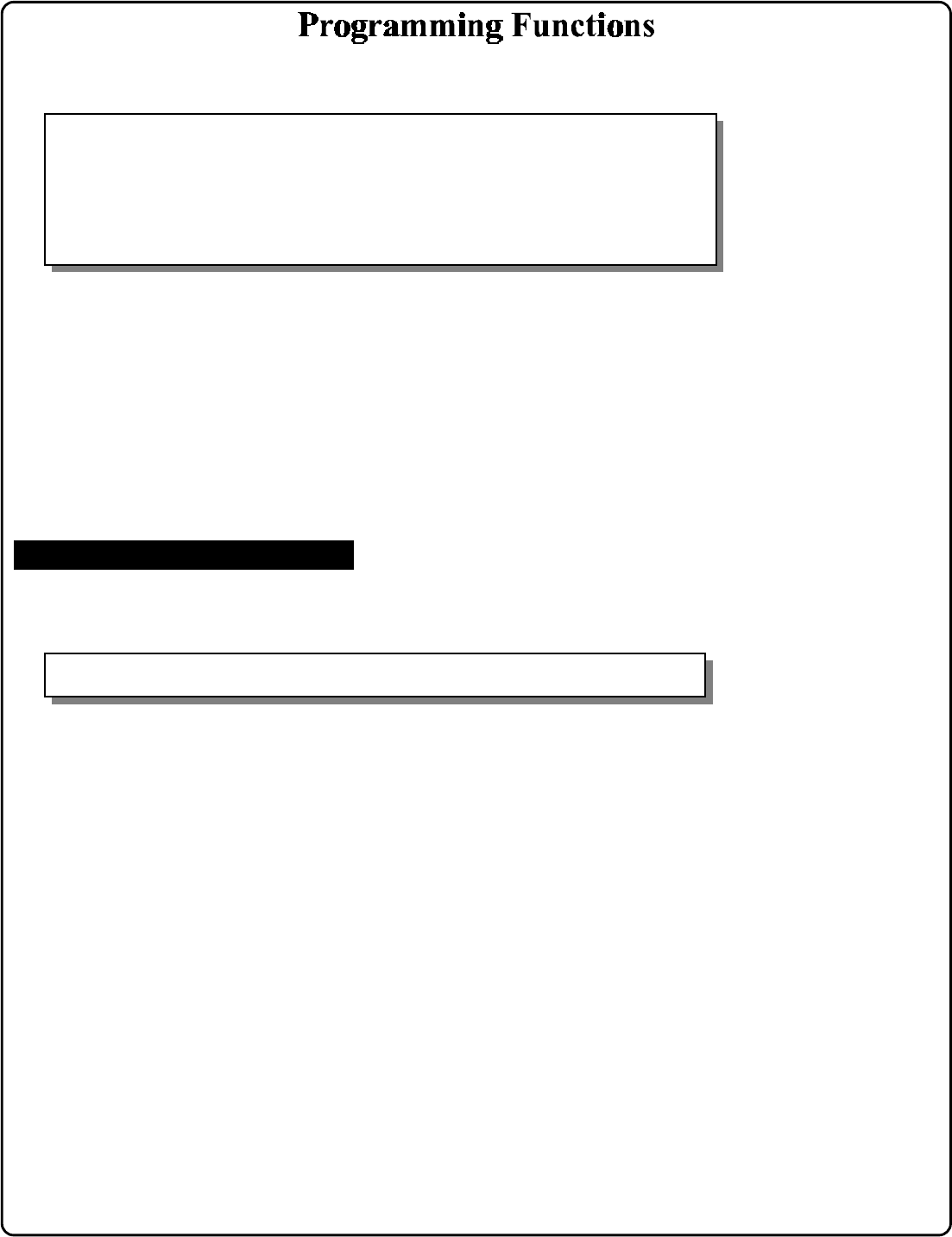
28
; 9 9 ; 0 0 0 :99. Clear All Lock Programming
Clears all programming. Audit Trail contents are maintained. M
CLEAR ALL PROGRAMMING
94 - 98. Reserved
92. Enable Group 4
(Open Time Window)
; 9 2 ; [ _ ] ; [ _ _ _ _ ] :
(Day) (Time)
• For day enter: 1 for Sunday, 2 for Monday, 3 for Tuesday, 4 for Wednesday, 5 for
Thursday, 6 for Friday and 7 for Saturday, 8 for Monday to Friday, 9 for Saturday and
Sunday, 0 for all days of week.
• Enter time of day in 24 hour format.
Enter the Open and Close Window Functions below to set up a Window where if any Group
1 User Code is entered within the programmed window, Group 4 will be enabled. See
Group 1 Member enables Group 4 Members on page 6.
Scheduled Group 4 Enable (Group 1 Activated)
93. Enable Group 4
(Close Time Window)
; 9 3 ; [ _ ] ; [ _ _ _ _ ] :
(Day) (Time)
3
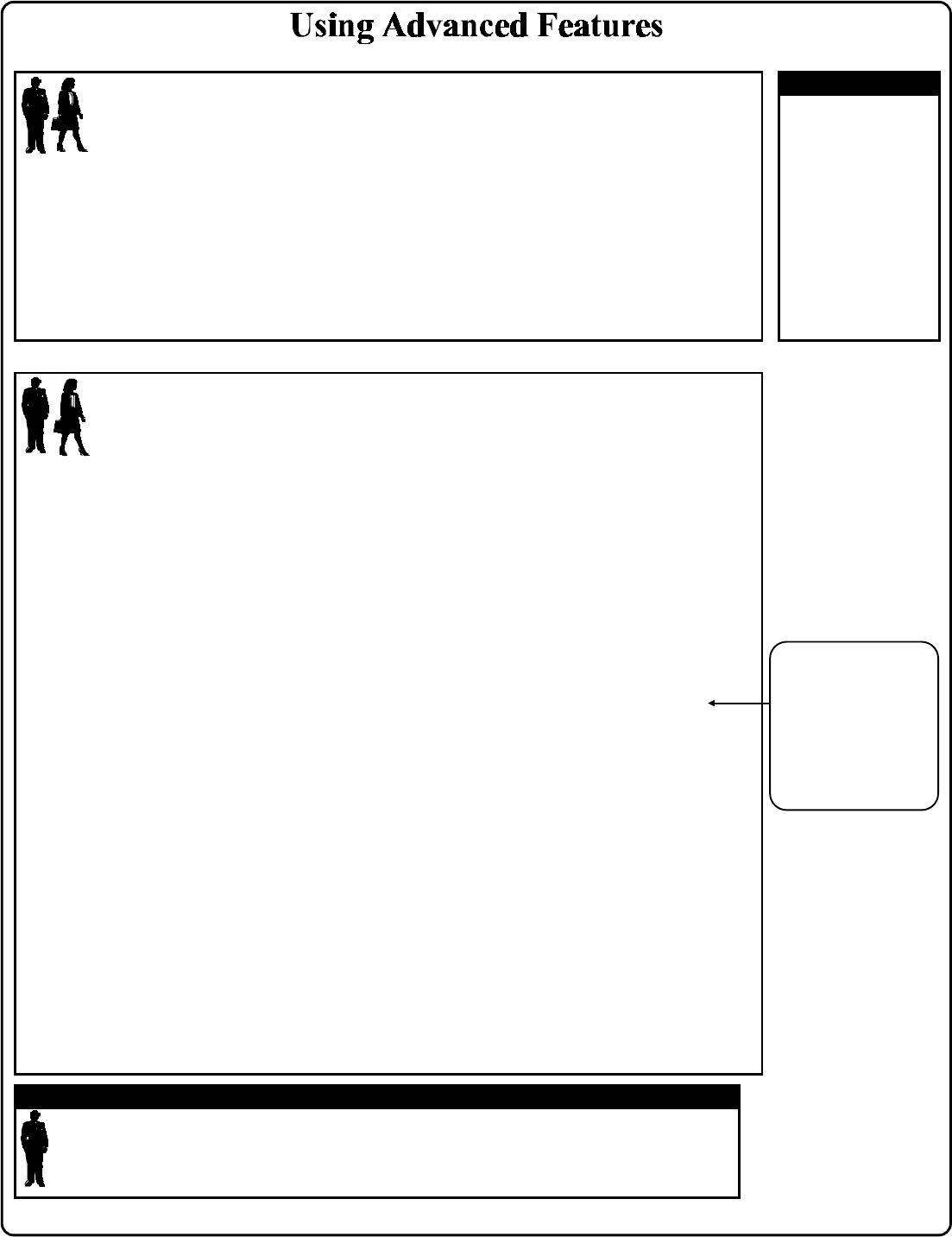
29
Advanced User Programming
Add a User that is a member of Group 2 & Group 3
Program a User Code of 789 that is a member of Group 2. Refer to Function 2 (page 15). Use Function 2,
and add the new user as User 101 (Users 101-150 are members of Group 2):
Add User 101:
; 2 ; 1 0 1 ; 7 8 9 :
Make User 101 also member of Group 3 using Function 35:
; 3 5 ; 1 0 1 ; 2 3 :
Note: Although User 101 is by default a member of Group 2, Group 2 must be included when making changes to the
Group Association using Function 35 or the Group 2 association will be removed.
Group 1 Activated Features
Add a User to Group 1
Program a User Code of 456789 that is also a member of Group 1. Use Function 2, and add the new user as
User 4 (Manager).
Add User 4:
; 2 ; 4 ; 4 5 6 7 8 9 :
Make User 4 a member of Group 1 by using Function 35:
; 3 5 ; 4 ; 1 :
Add Schedule that Opens the Lock (Passage Mode) when a member of Group 1 enters their code.
Program a schedule using Function 88 and Function 89 between the hours of 6 A.M. and 10 A.M. for all days of the week.
Enter the Open Window Time of 6 A.M.: ; 8 8 ; 0 ; 0 6 0 0 :
Enter the Close Window Time of 10 A.M.: ; 8 9 ; 0 ; 1 0 0 0 :
The Lock will now be put in passage mode IF User 4 (or any Group 1 User) enters their code between 6 A.M. and 10 A.M.
The Lock will have to be manually locked each night by entering the following command using Function 46.
Manually close the Lock by entering the following command:
; 4 6 :
The Lock can also be programmed to automatically close each night at 6 P.M. by adding a scheduled Lock Time using
Function 73:
Automatically (Scheduled Lock) close the Lock by entering the following command:
; 7 3 ; 0 ; 1 8 0 0 :
Other Group 1 Initiated (Manager) Functions include:
Disarming a Burglar Alarm (Relay Activation) See functions 90/91.
Group 4 Enable - See functions 92/93.
The example to add
Users to Group 2 and
Group 3 has been
selected due to the fact
that Group 1 Activated
Functions require that a
member a Group 1 enter
their code to activate the
function. Do not add
general users to Group 1
if Manager Initiated
Functions are to be
programmed - Functions
88/89, 90/91 and 92/93.
Note:
Note:
To Change to a different
Group 1 Activated
Function.
Replace functions 88 & 89
(Passage Mode Enable)
with functions 90/91
(Burglar Alarm Disarm)
or 92/93 (Group 4
Enable).
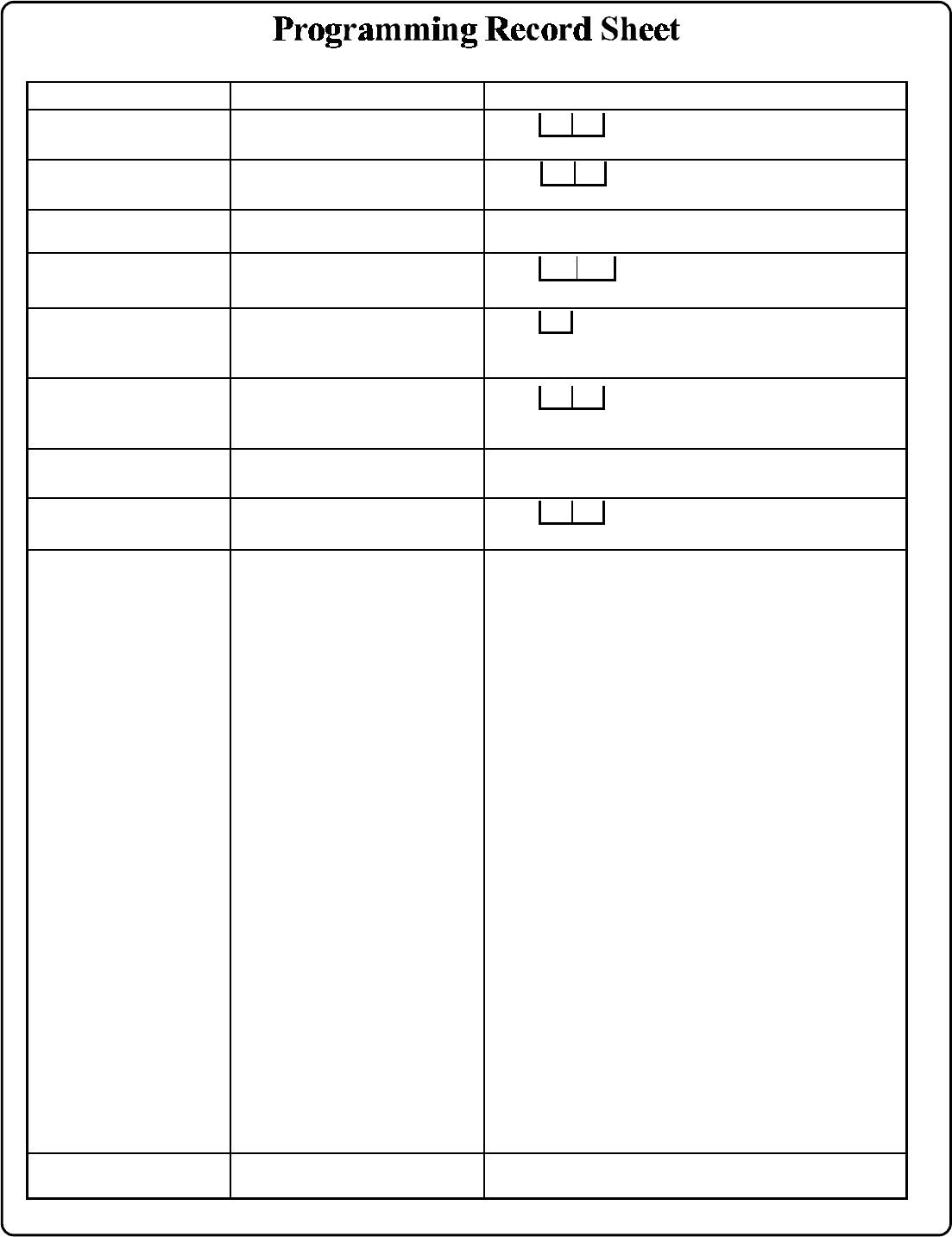
30
Function Number(s) Function Name Programming
41 Daylight Savings Time Code
43/44 Clock Adjust
52/53/54 Pass Time (3 sec) oo 10 sec oo 15 sec oo
59 AL-DTM Door Number
60 Set Lockout Attempts
61 Set Lockout Time
64/65 Remote Input
Disable/Enable (Enable) oo Disable oo
66 Ambush Code
67 Add Relay/System Features
69/70 Enter Key (Enable) oo Disable oo
+/- 0-55
(0) (0) Seconds
1-96 (48 for AL-DTM (Version 1)
(0) (1) Door Number
1-9 Attempts
(6)
1-60 seconds
(1) (5)
00-99
(9) (9) Ambush Code
Default Values are shown in parentheses.
01-24
(1) (2) DST Code
Check all that apply
1. Remote Input while enabled oo
2. Remote Input while disabled oo
3. Failed Entry Attempt oo
4. Disabled user entered code oo
5. Access Granted oo
6. Scheduled (Group 1 Activated) oo
7. Locked by Schedule oo
8. Unlocked by Schedule oo
9. Lock Out oo
10. Ambush Tripped oo
11. Any Key Press/Card Entry oo
25. Disable Sounder oo
26. 5 sec. Delayed Entry oo
27. 15 sec. Delayed Entry oo
28. 45 sec. Delayed Entry oo
29. Remote Input Toggles Passage Mode oo
30. Forced Unlock Follows Remote Input oo
31. Relay Follows Lock/Unlock Status oo
32. Remote Input Disables Unit (Hold all States) oo
33. Remote Input Puts Unit in PC Comm. Mode oo
34. Forced Lock follows Remote Input oo
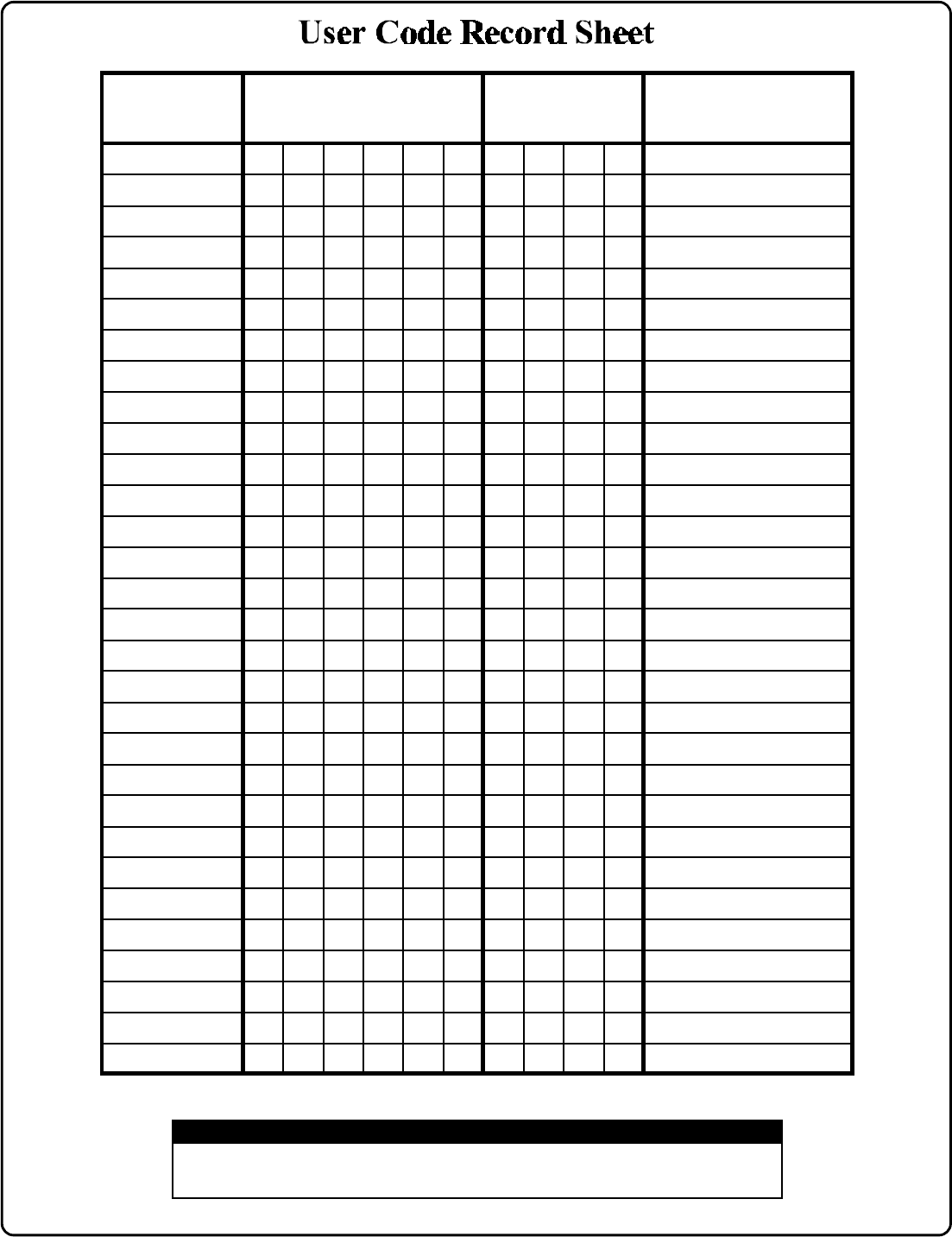
31
User Number
(1-2000) User Code
(3-6 digits) Group
Association User Name
1 2 3 4
For a complete list of user codes, obtain a printout from either the remote printer
(Program Function 56) or using the DL-WINDOWS Software.
Note:
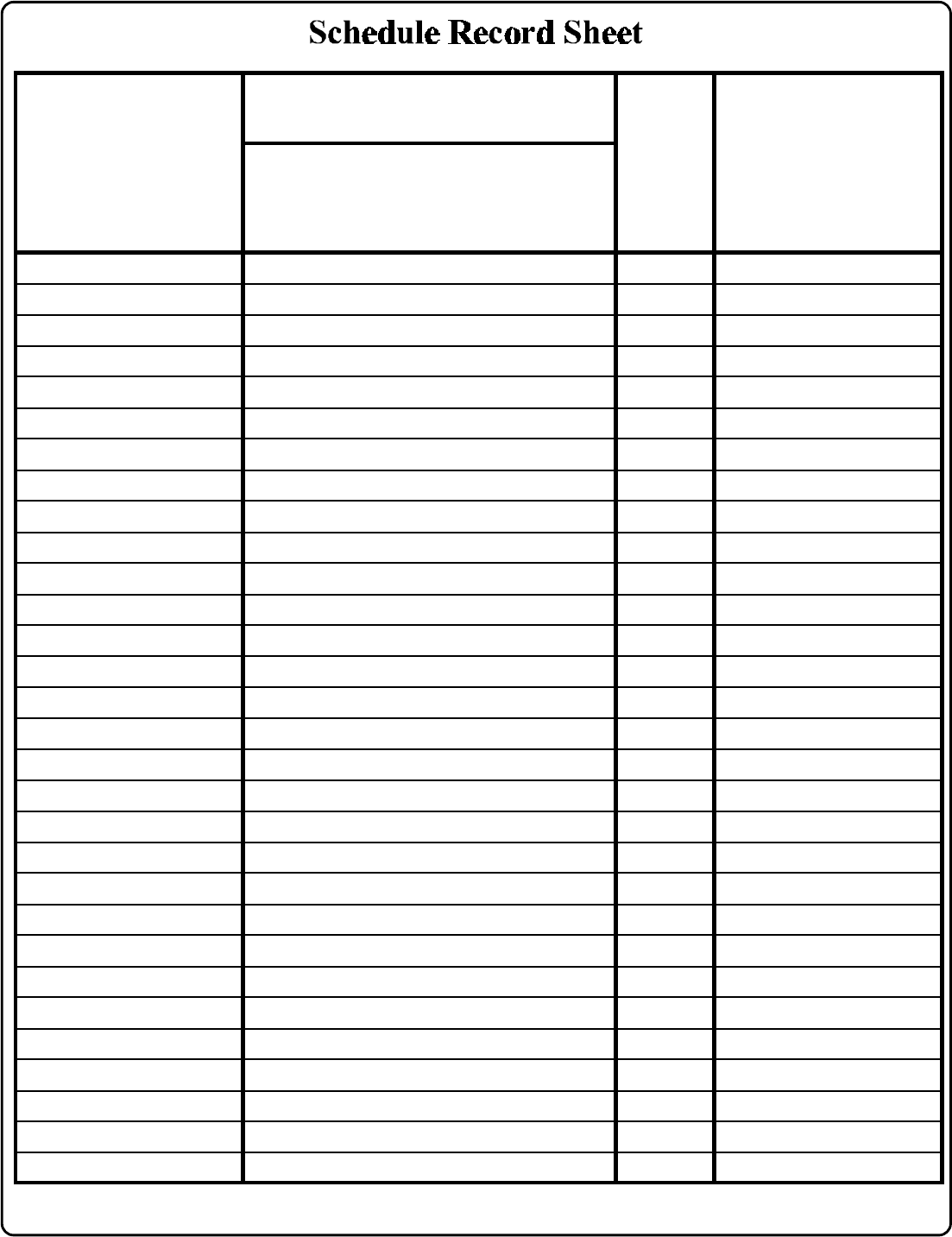
32
Day(s)
Function Number
Up to 500 scheduled functions can be programmed (Up to
only 150 using AL-DTM2). For Day Enter :
1 = Sunday, 2 = Monday, 3=Tuesday, 4 Wednesday
5 = Thursday, 6 = Friday, 7=Saturday, 8 = Monday - Friday
9 = Saturday and Sunday, 0=All days of the week
Enter time of day in 24 hour format (00:00- 23:59)
Time Function Name
:
:
:
:
:
:
:
:
:
:
:
:
:
:
:
:
:
:
:
:
:
:
:
:
:
:
:
:
:
:

33
ACCESS = Entry into a restricted area.
AMBUSH = An AMBUSH CODE used before a USER CODE and programmed for Relay Ambush can be used to alert security, or trip a
silent-alarm on a Burglary Control Panel.
AUDIT TRAIL = A log of previously date/time stamped events that have occurred.
BURGLARY CONTROL PANEL = Provides local alarm and remote communication to request security for burglary/break-in. A PDL3000 relay
output used for Ambush can provide a silent-alarm and call-for-help.
CLOCK
• REAL TIME CLOCK = An accurate built-in clock that allows date/time stamping of events. The clock can be slowed or speeded up to fine
tune long term accuracy of the clock to within three minutes per year.
• CLOCK SETTINGS = Printout includes date, time, weekday, and clock speed.
• CLOCK SPEED = The clock can be adjusted to allow faster/slower speeds and therefore increasing clock accuracy.
CODE = Numeric sequence of numbers (such as: 123). If Star-Enter-Key is required, must be followed by a [*] key.
• AMBUSH CODE = A predefined two-digit AMBUSH CODE entered before a USER CODE, with RELAY AMBUSH ACTIVATED. Causing
the door to unlock and cause the relay to momentarily close, for a Security Team to respond. A Burglary Control Panel can send a
Silent-Alarm requesting security response through remote communication.
• BASIC USER CODE = User Code used by User 12-50, 251-296, 301-2000. (Does not allow programming)
• INSTALLER CODE = User Code used by User 2-3. (Allows all programming except master functions)
• INVALID CODE = A code that has not been programmed in the lock.
• MANAGER CODE = User Code used by User 4-6. (Allows most of the programming functions)
• MASTER CODE = User Code used by User 1. Default code is 123456. Master Code has complete control of the lock.
• PRINT ONLY USER CODE = User Code used by User 10-11. (Allows no programming except print functions)
• QUICK ENABLE USER 300 CODE = User code 297 used to Re-enable Service Code User Code 300.
• QUICK PC ACCESS CODE = Permits upload/download to DL-Windows Software on IBM/compatible computer running Microsoft
Windows 95, 98, or NT 4.0.
• SERVICE CODE = User 300. Allows only one entry, then needs to be re-enabled by another code to regain access again.
• SUPERVISOR CODE = User Code for User 7 to 9. Can only program day-to-day operation, no default group association.
• USER CODE = Code used by Users. Code is 3 to 6 numeric digits long, allowing controlled entry through door.
• VALID CODE = An entered code that has been programmed in the unit.
COM PORT = A computer serial communications port used to communicate with the Lock and/or Data Transfer Module.
DATA TRANSFER MODULE = A device that permits transfer of program/data between a computer and up to 96 locks.
DATE = Month, Day and Year entered as MMDDYY.
DAY OF WEEK = Sunday through Saturday (where 1 = Sunday and 7 = Saturday).
DELAYED ENTRY = Delays user passage through door, allowing camera/security guard to observe the person passing through the door.
DISABLE = Turn off.
DL-Windows = Computer software used to communicate with the Lock and/or Data Transfer Module.
DOOR NUMBER = Identification of each door with a specific number (1-96). (Used with AL-DTM2 Transfer Module)
ENABLE = Turn on.
EVENTS = Recorded lock activity.

34
FUNCTION (also called Programming Functions) = are the numbers used to program lock features (enabling/disabling Users, User Groups,
Passage Mode, Schedules, etc.).
GROUP
• USER GROUP = Defining a user to specific groups, allows user entry when the group is allowed entry.
• GROUP 1 DISARMS BURGLAR CONTROL = Manager Group 1 USER CODE entry can disarm an alarm panel during a predefined schedule.
Should the Manager enter outside of the scheduled time, the alarm will not disarm. The alarm panel must be armed through other means (such
as an Alarm Panel Keypad). The Burglary Alarm Panel must be programmed to disarm from an Armed State Only and the zone input must be
programmed for input disarming.
• GROUP 1 ENABLES GROUP 4 USERS = Manager Group 1 USER CODE entry during a predefined schedule will allow access to Group 4
Users.
• GROUP 1 PUTS UNIT IN PASSAGE = Manager Group 1 USER CODE entry during a pre-defined schedule will unlock unit.
INSTALLER = See.... CODE, INSTALLER.
KEYFOB = A special keychain HID device. It is used in the same manner as a Prox Card by placing it near the Prox Card Reader.
KEYPAD = 10-numeric keys, asterisk and special [AL] key.
KEYPAD PROGRAMMING = Ability to program the lock through the keypad.
KEYPRESS = Pressing a button on the Lock’s Keypad.
LEVEL ABILITY = Predefined User Types (such as Master, Installer, Manager, Supervisor, and Print Only User) have specific abilities to program
and/or control the lock.
• LOCKOUT = Keypad is programmed to lockout users, for a specified period of time, when a specified number of invalid code entries are
performed.
• LOCKOUT ATTEMPTS = A specified number of invalid user code entries (1-9), that will disable the keypad for a predefined period of time
(1-60 seconds).
LOCKOUT TIME = A predefined time (1-60) seconds that the lock will stop accepting codes, after a specified number of invalid user code entries
(1-9).
LOG = See... AUDIT TRAIL.
MANAGER = See... CODE, MANAGER.
MASTER = See... CODE, MASTER.
PASSAGE = Allow anyone to pass through the door without USER CODES. (Door is Unlocked)
PRINTER = A printout device (such as: An Infrared Printer or computer printer).
PROGRAM MODE = A mode allowing program/data to be entered through the keypad. Only specific users can program a lock manually, by
entering their USER CODE, followed by the [AL] key. To exit program mode, hold any key until repeated beeps are heard.
PROGRAMMABLE RELAY FUNCTIONS = The relay can be programmed for one or more functions.
PROX CARD = A special plastic card HID device that is detected when by placed near the PDL3000 or PROX Card Reader.
RELAY = Switched output allowing remote control of other devices. External power source is required.
• Relay, Ambush Activated - Ambush Code entered prior to a User Code will trip a relay. This will alert Security or trip a zone on an Alarm Panel.
• Relay, Any Keypress - First keypress of any sequence.
• Relay, Authorized Entry - Valid User Code entered.
• Relay, Disabled User Entered Code - Valid User Code entered but the user is disabled.
• Relay, Failed Entry Attempt - Invalid User Code entered.
• Relay, Lockout - Should several Invalid User Codes be entered that exceed the number of lockout attempts (1-9), then the lock will stop accepting
keypad entries for the Lockout Time (1-60 seconds). The Relay output can be used to indicate tampering of the keypad.
• Relay, Group 1 Activation - A Group 1 Manager can enter a User Code and can disarm a Burglary Alarm Panel using the Relay Output.

35
REMOTE INPUT = Entry into a restricted area, by pressing a button connected to the REMOTE INPUT WIRES (White and White) by someone on
the other side of the door.
SCHEDULE = A programmed operation (enable/disable, lock/unlock, etc.) on a specific weekday (Sunday through Saturday) and time.
SCHEDULES, QUICK = Any one of four most common types of schedules can be programmed.
TIME = Hours and Minutes in the HHMM format.
TIME/DATE STAMP = A date and time that an event occurred.
TIMEOUT = Immediate operation for a specified number of hours.
USER = A person who has been provided with a USER CODE for access through the door.
• USER LOCKOUT, TOTAL = All users (except for Master Code) have been locked out.

36
ALARM LOCK LIMITED WARRANTY
ALARM LOCK SYSTEMS, INC. (ALARM LOCK) warrants its products to be free from manufacturing defects in materials and
workmanship for 24 months following the date of manufacture. ALARM LOCK will, within said period, at its option, repair or
replace any product failing to operate correctly without charge to the original purchaser or user.
This warranty shall not apply to any equipment, or any part thereof, which has been repaired by others, improperly installed,
improperly used, abused, altered, damaged, subjected to acts of God, or on which any serial numbers have been altered,
defaced or removed. Seller will not be responsible for any dismantling or reinstallation charges.
THERE ARE NO WARRANTIES, EXPRESS OR IMPLIED, WHICH EXTEND BEYOND THE DESCRIPTION ON THE FACE
HEREOF. THERE IS NO EXPRESS OR IMPLIED WARRANTY OF MERCHANTABILITY OR A WARRANTY OF FITNESS FOR
A PARTICULAR PURPOSE. ADDITIONALLY, THIS WARRANTY IS IN LIEU OF ALL OTHER OBLIGATIONS OR LIABILITIES
ON THE PART OF ALARM LOCK.
Any action for breach of warranty, including but not limited to any implied warranty of merchantability, must be brought within the
six months following the end of the warranty period. IN NO CASE SHALL ALARM LOCK BE LIABLE TO ANYONE FOR ANY
CONSEQUENTIAL OR INCIDENTAL DAMAGES FOR BREACH OF THIS OR ANY OTHER WARRANTY, EXPRESS OR
IMPLIED, EVEN IF THE LOSS OR DAMAGE IS CAUSED BY THE SELLER'S OWN NEGLIGENCE OR FAULT.
In case of defect, contact the security professional who installed and maintains your security system. In order to exercise the
warranty, the product must be returned by the security professional, shipping costs prepaid and insured to ALARM LOCK. After
repair or replacement, ALARM LOCK assumes the cost of returning products under warranty. ALARM LOCK shall have no
obligation under this warranty, or otherwise, if the product has been repaired by others, improperly installed, improperly used,
abused, altered, damaged, subjected to accident, nuisance, flood, fire or acts of God, or on which any serial numbers have been
altered, defaced or removed. ALARM LOCK will not be responsible for any dismantling, reassembly or reinstallation charges.
This warranty contains the entire warranty. It is the sole warranty and any prior agreements or representations, whether oral or
written, are either merged herein or are expressly canceled. ALARM LOCK neither assumes, nor authorizes any other person
purporting to act on its behalf to modify, to change, or to assume for it, any other warranty or liability concerning its products.
In no event shall ALARM LOCK be liable for an amount in excess of ALARM LOCK's original selling price of the product, for any
loss or damage, whether direct, indirect, incidental, consequential, or otherwise arising out of any failure of the product. Seller's
warranty, as hereinabove set forth, shall not be enlarged, diminished or affected by and no obligation or liability shall arise or grow
out of Seller's rendering of technical advice or service in connection with Buyer's order of the goods furnished hereunder.
ALARM LOCK RECOMMENDS THAT THE ENTIRE SYSTEM BE COMPLETELY TESTED WEEKLY.
Warning: Despite frequent testing, and due to, but not limited to, any or all of the following; criminal tampering, electrical or
communications disruption, it is possible for the system to fail to perform as expected. ALARM LOCK does not represent that the
product/system may not be compromised or circumvented; or that the product or system will prevent any personal injury or
property loss by burglary, robbery, fire or otherwise; nor that the product or system will in all cases provide adequate warning or
protection. A properly installed and maintained alarm may only reduce risk of burglary, robbery, fire or otherwise but it is not
insurance or a guarantee that these events will not occur. CONSEQUENTLY, SELLER SHALL HAVE NO LIABILITY FOR ANY
PERSONAL INJURY, PROPERTY DAMAGE, OR OTHER LOSS BASED ON A CLAIM THE PRODUCT FAILED TO GIVE
WARNING. Therefore, the installer should in turn advise the consumer to take any and all precautions for his or her safety
including, but not limited to, fleeing the premises and allege police or fire department, in order to mitigate the possibilities of harm
and/or damage.
ALARM LOCK is not an insurer of either the property or safety of the user's family or employees, and limits its liability for any loss
or damage including incidental or consequential damages to ALARM LOCK's original selling price of the product regardless of the
cause of such loss or damage.
Some states do not allow limitations on how long an implied warranty lasts or do not allow the exclusion or limitation of incidental
or consequential damages, or differentiate in their treatment of limitations of liability for ordinary or gross negligence, so the above
limitations or exclusions may not apply to you. This Warranty gives you specific legal rights and you may also have other rights
which vary from state to state.

37
Part 15 Manual Statement
The following statement should be conspicuously located in bold
letters in the instruction manual:
CAUTION: Changes or modifications not expressly approved by Napco
Security Systems could void the user’s authority to operate the
equipment.
RADIO AND TELEVISION INTERFERENCE
This equipment has been tested and found to comply with the
limits for a Class B digital device, pursuant to Part 15 of
the FCC rules. These limits are designed to provide
reasonable protection against harmful interference in a
residential installation. This equipment generates, uses
and can radiate radio frequency energy and, if not installed
and used in accordance with the instructions, may cause
harmful interference to radio communications. However,
there is no guarantee that interference will not occur in a
particular installation. If this equipment does cause
harmful interference to radio or television reception, which
can be determined by turning the equipment off and on, the
user is encouraged to try to correct the interference by one
or more of the following measures:
- Reorient or relocate the receiving antenna.
- Increase the separation between the equipment and
the receiver.
- Connect the equipment into an outlet on a circuit
different from that to which the receiver is
connected.
- Consult the dealer or an experienced radio/TV
technician for help.
You may also find helpful the following booklet,
prepared by the FCC: "How to Identify and Resolve Radio-TV
Interference Problems." This booklet is available from the
U.S. Government Printing Office, Washington D.C. 20402.
Changes and Modifications not expressly approved by
the manufacturer or registrant of this equipment can void
your authority to operate this equipment under Federal
Communications Commissions rules.